Glacier Express from St. Moritz to Zermatt
In my last post from this trip to Switzerland with Adventures Abroad our group started our hiking portion of the itinerary with a bracing ramble in the Engadin Valley high above St. Moritz. Now it is time to enjoy one of the many exciting train trips that was one of the main attractions for signing on to this tour. None is more famous than the Glacier Express that runs between St. Moritz and Zermatt and in this post I’ll do my best to explain why it is a trip that every train enthusiast should do once in a lifetime.
History of the Glacier Express
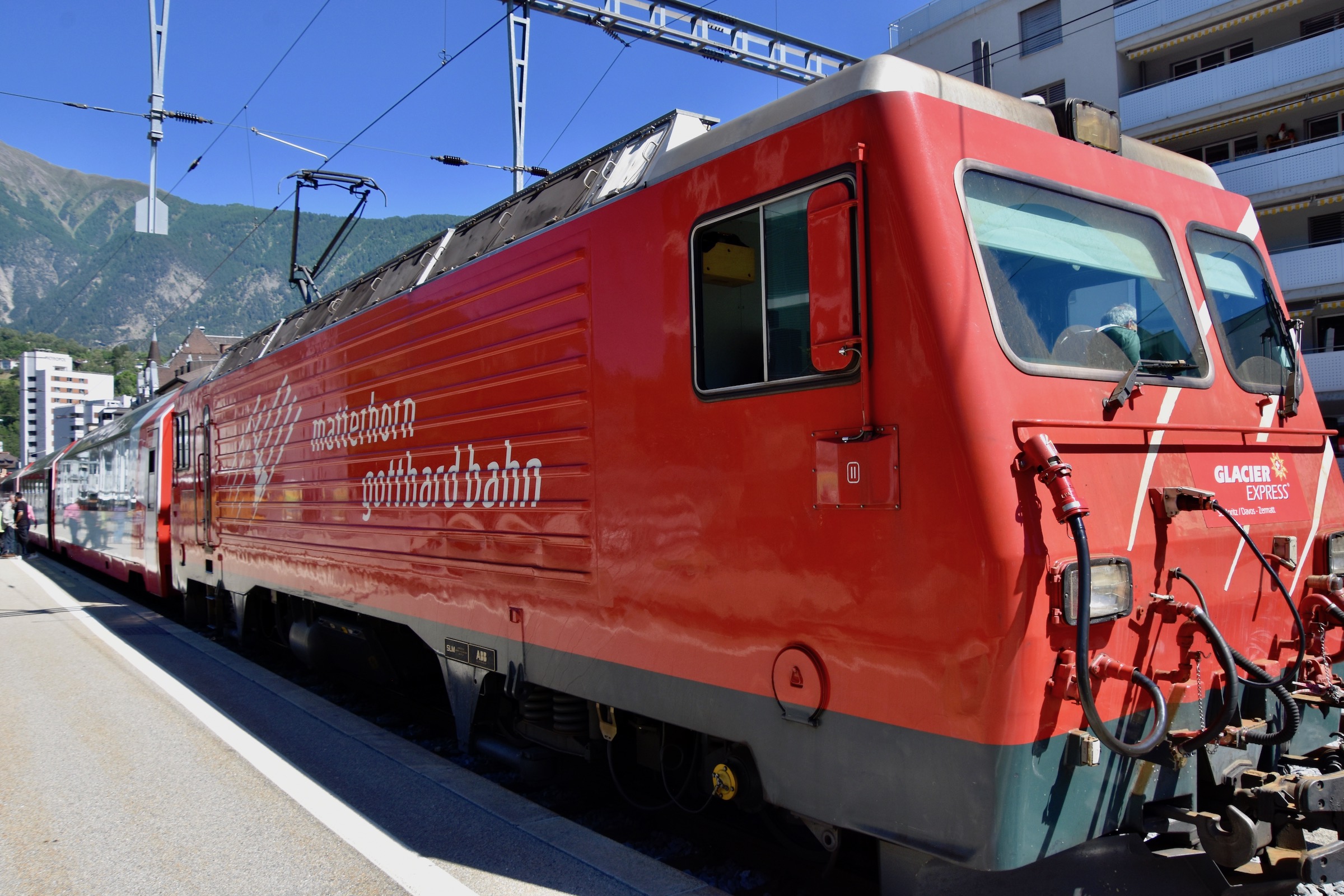
The Swiss were among the pioneers of rail development in an area that at first glance doesn’t seem amenable to rail traffic – the Alps. After all trains travel horizontally and the Swiss alps are distinctly vertical. The solution for the Swiss was to go over valleys with huge elevated trestles and through the mountains with some of the earliest and longest rail tunnels in the world. The Gotthard Pass route was opened in 1882 and the Simplon Pass in 1902. They continue to be marvels of rail engineering to this day.
By contrast the Glacier Express route was a relatively late and less complex endeavour, first opening in 1930. Up until 1982 when the Furka Base Tunnel was completed, it ran only during the summer months.
This is a map of the route which traverses a substantial portion of the Swiss alps in the eight hour journey over a distance of 181 miles (291 kms.) between St. Moritz and Zermatt. Along the way it passes over 291 bridges and 91 tunnels.
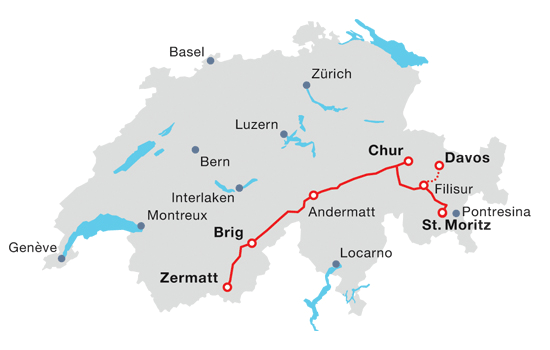
Armed with our Swiss Travel passes our AA guide Victor Romagnoli leads us down to the train station and it’s ‘All Aboard!’ on the Glacier Express. What follows is a chronological photo essay on this marvellous train trip.
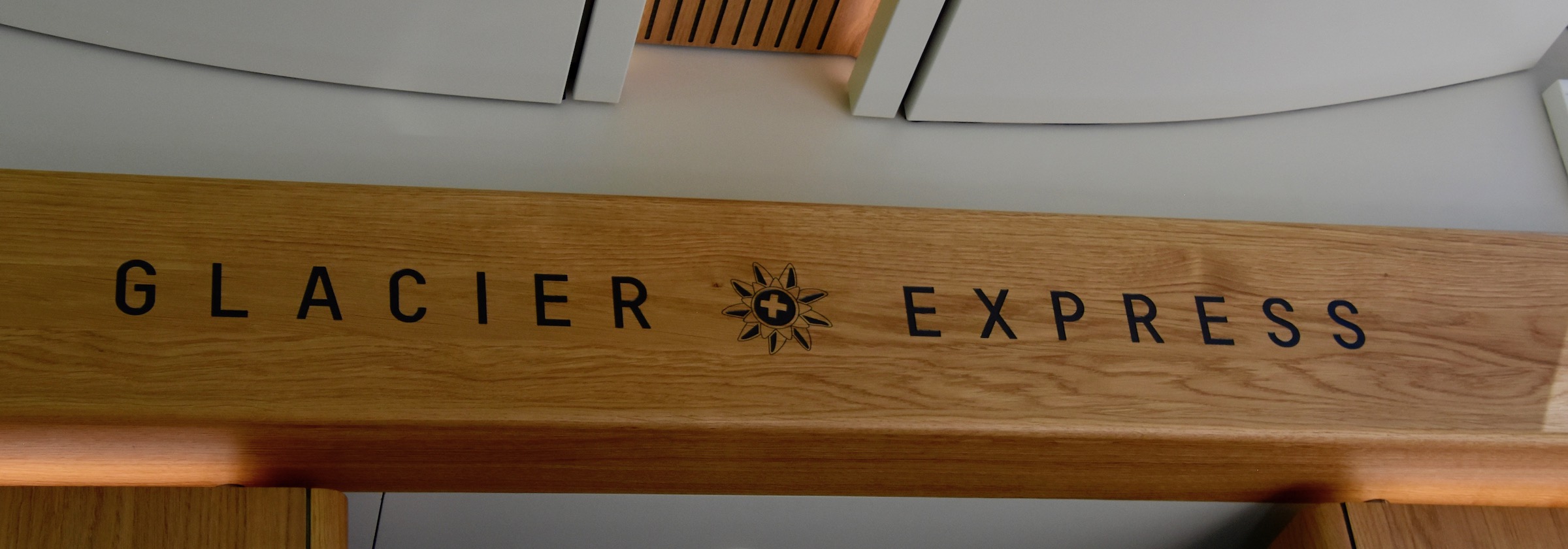
Somehow I got so caught up in looking at what was going on outside that I forgot to take a picture of the interior of the rail car to which we were assigned. Needless to say the seats were quite comfortable with a table in between. There was lots of room to move round and places between cars where you could get open air photos without the glare from glass windows. However, these were in high demand, particularly in the most scenic areas, but if you moved around you could usually find a good vantage point.
Each seat had a connection to an audio system much like on an airplane. On the route there were 35 points at which a bell would ring to alert you to put on the ear buds to hear a description of what you were seeing outside or impart some historical information. The only problem was that at least half the time I would be somewhere other than my seat when the bell rang so I missed a lot of the commentary. However, that need not have been the case. I could have used the Glacier Express Wifi system on my iPhone and accessed an app showing a map of the route and giving commentary along the way. In truth though you will probably spend more time looking than listening.
The Glacier Express starts out at an elevation of 1775 metres ( 5823 feet) and then makes a long descent down to the Rhine River at Chur before rising all the way up to the Oberalpass at 2,033 metres (6,670 feet) then down again to Brig before ascending again to Zermatt at 1,604 metres (5,262 feet). Folks we are in for an eight hour roller coaster ride.
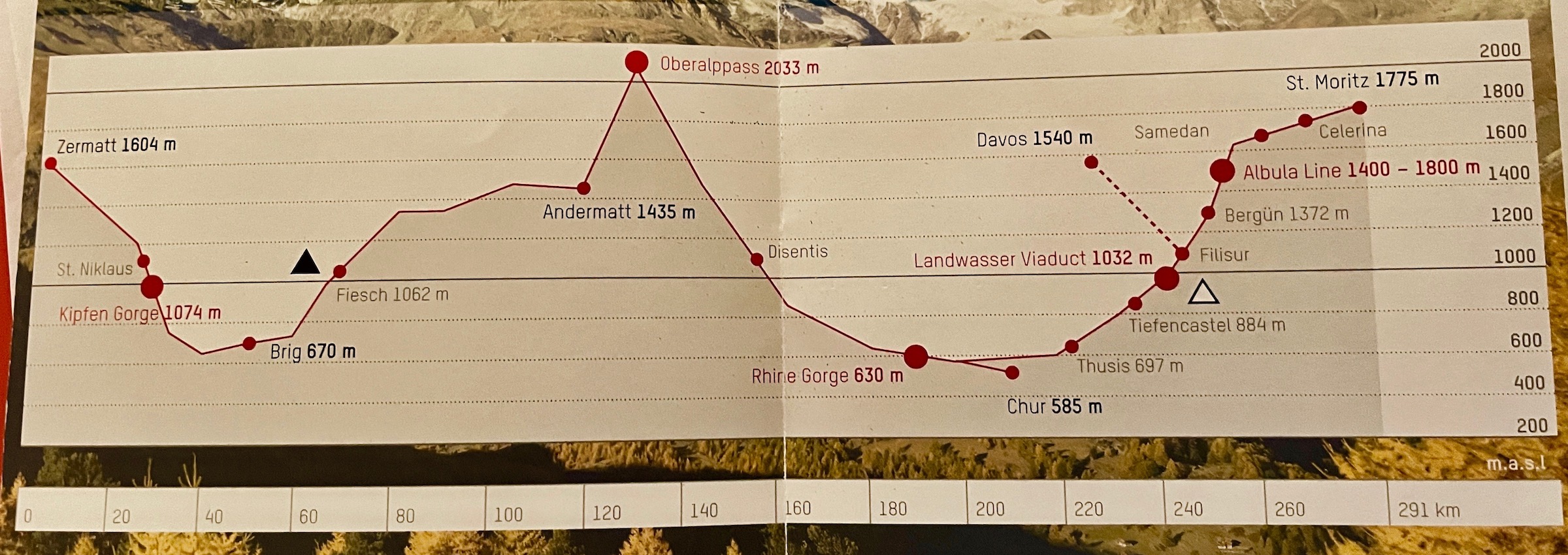
This is the view heading out of the Engadin Valley past the village of Celerina. We have a gloriously warm and mostly sunny day for our Glacier Express trip.
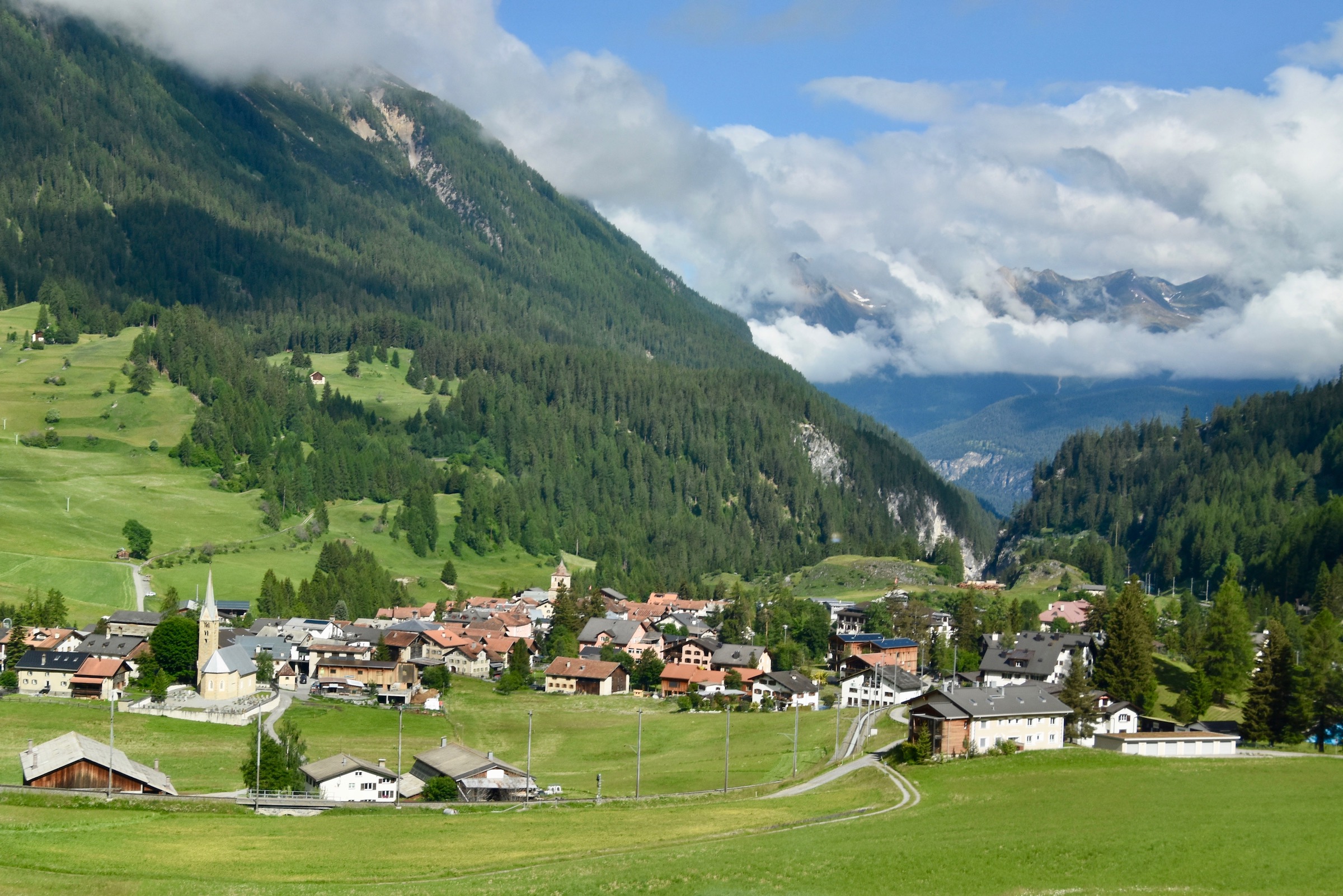
The portion of the Glacier Express route from St. Moritz to Thusis is officially the Albula Railway which is one of two routes that converge at St. Moritz to create the combined Rhaetian Railway which is a UNESCO World Heritage Site. Usually one thinks of these World Heritage Sites as a single definable place, but increasingly UNESCO has recognized that there is much more that should be designated than just buildings and in 2008 the Rhaetian Railway was inducted with this description of it Outstanding Universal Value:
The Rhaetian Railway in the Albula/Bernina Landscapes represents an exemplary railway development for the disenclavement of the Central Alps at the beginning of the 20th century. The railway’s socio-economic consequences were substantial and lasting for mountain life, the interchange of human and cultural values, and changes in the relationship between man and nature in the West. The Rhaetian Railway offers a wide diversity of technical solutions for the establishment of the railway in often severe mountain conditions. It is a well designed construction that has been realised with a high degree of quality and it has remarkable stylistic and architectural homogeneity. The railway infrastructure moreover blends in particularly harmoniously with the Alpine landscapes through which it passes.
One of the problems with being inside the Glacier Express is that you don’t get to see the fantastic scenes most often associated with it like the crossing of the Landwasser Viaduct as shown in this photo.
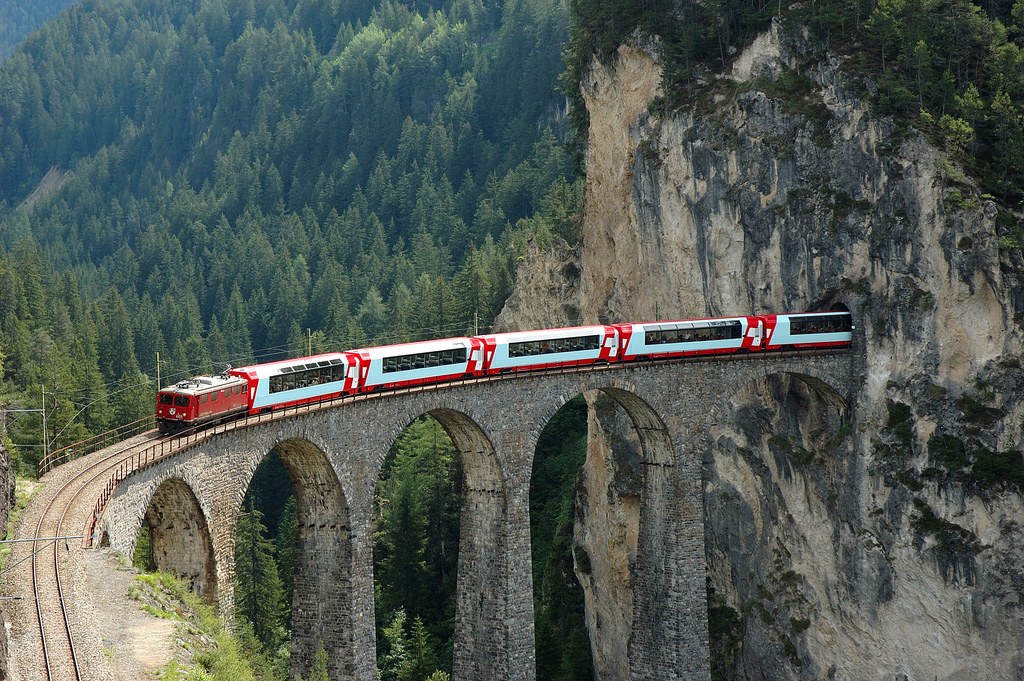
However, with a little head twisting I did manage to get some shots of the Glacier Express from the train, like this one taken not far after leaving the Engadin Valley.
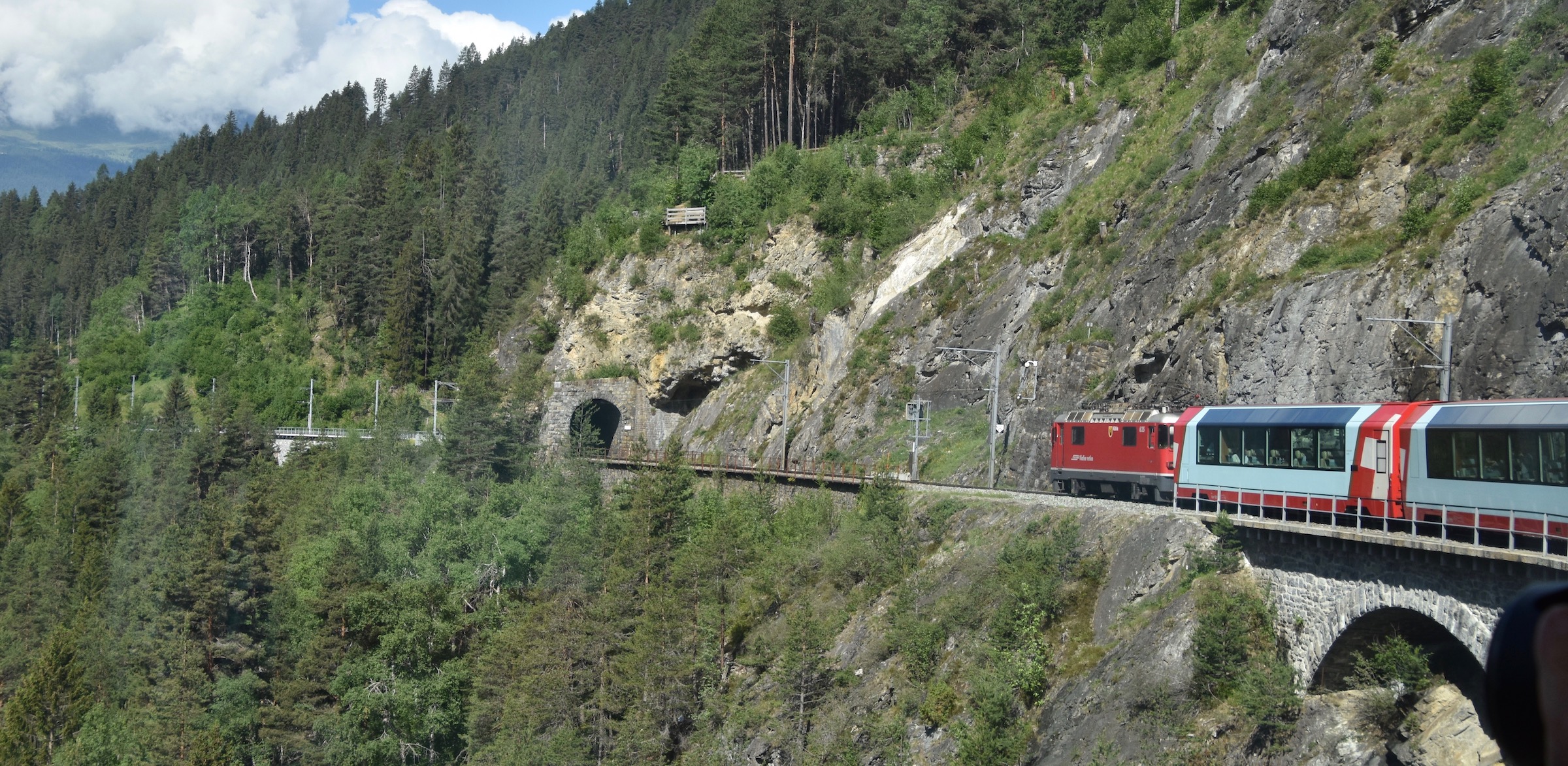
Another thing you cannot really appreciate from inside the train are the incredible spirals through the mountains that the line takes as it descends towards Chur. At one point there is a descent of over 400 metres (1300 feet) in elevation in only five kms. (three miles). This is one of the feats of engineering that make the Glacier Express famous for more than just its great scenery. During these steep descents and ascents you can hear the loud click as the train hooks onto a rack and pinion system without which the train would hurtle out of control on the downgrades and go nowhere on the upgrades.
This is the view as we pass one of the many small villages on the way to Chur.
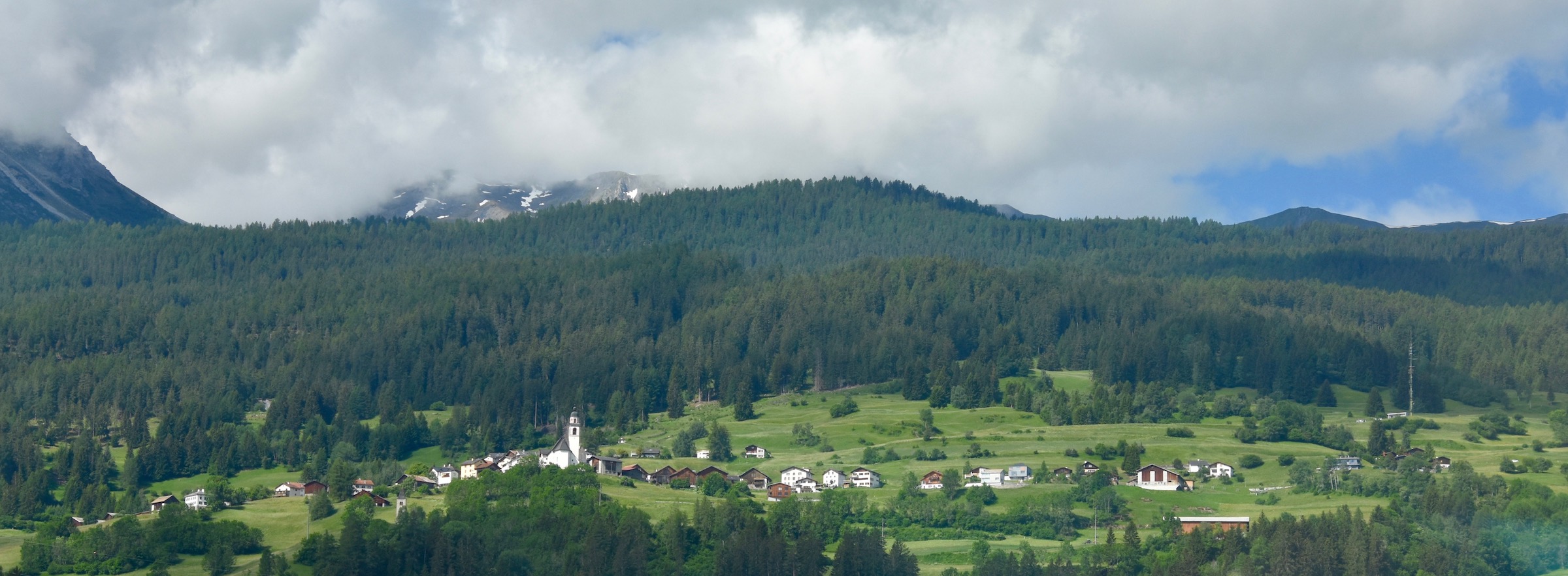
There are occasional monasteries, churches and castles set atop rugged crags that give a storybook feel to this alpine landscape.
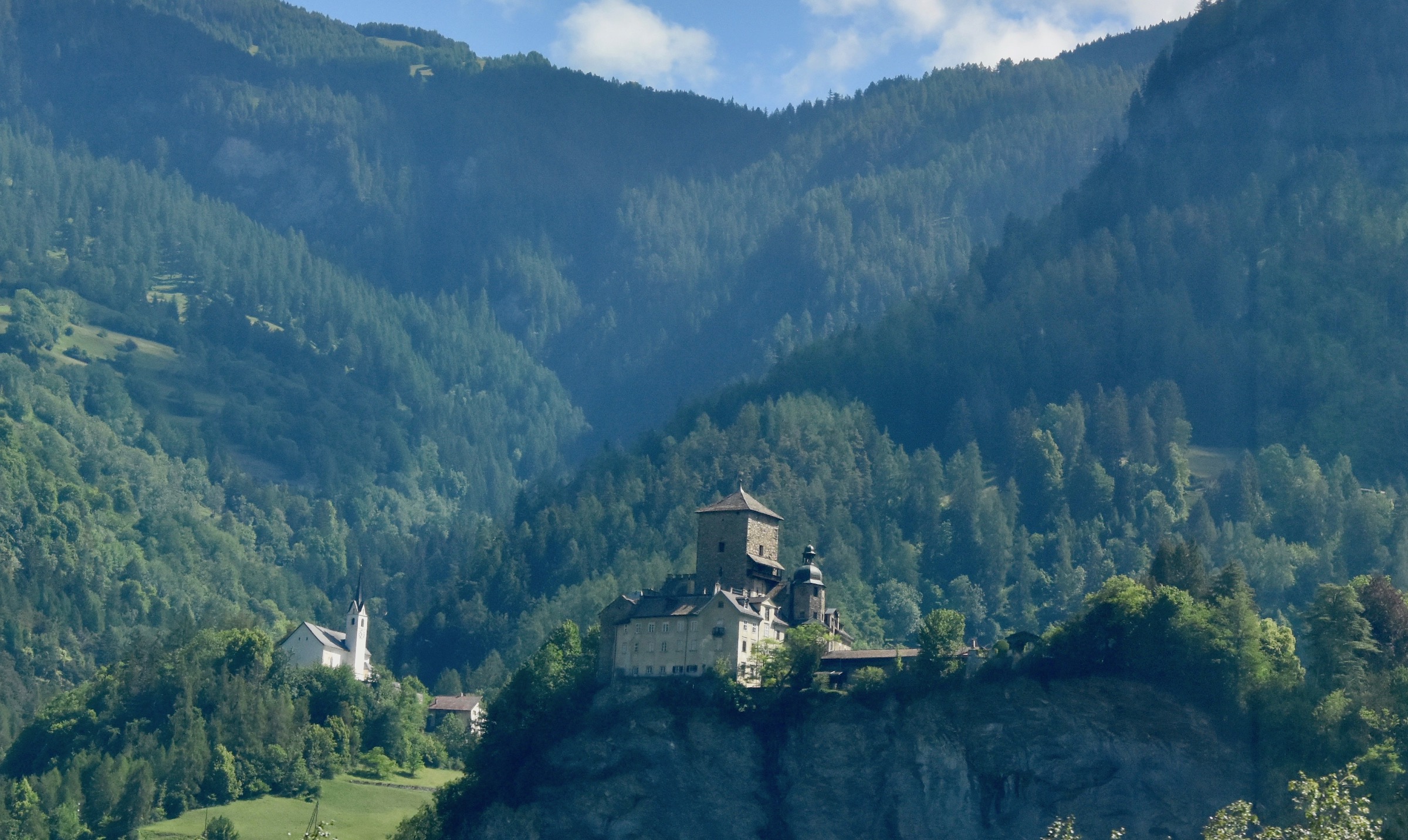
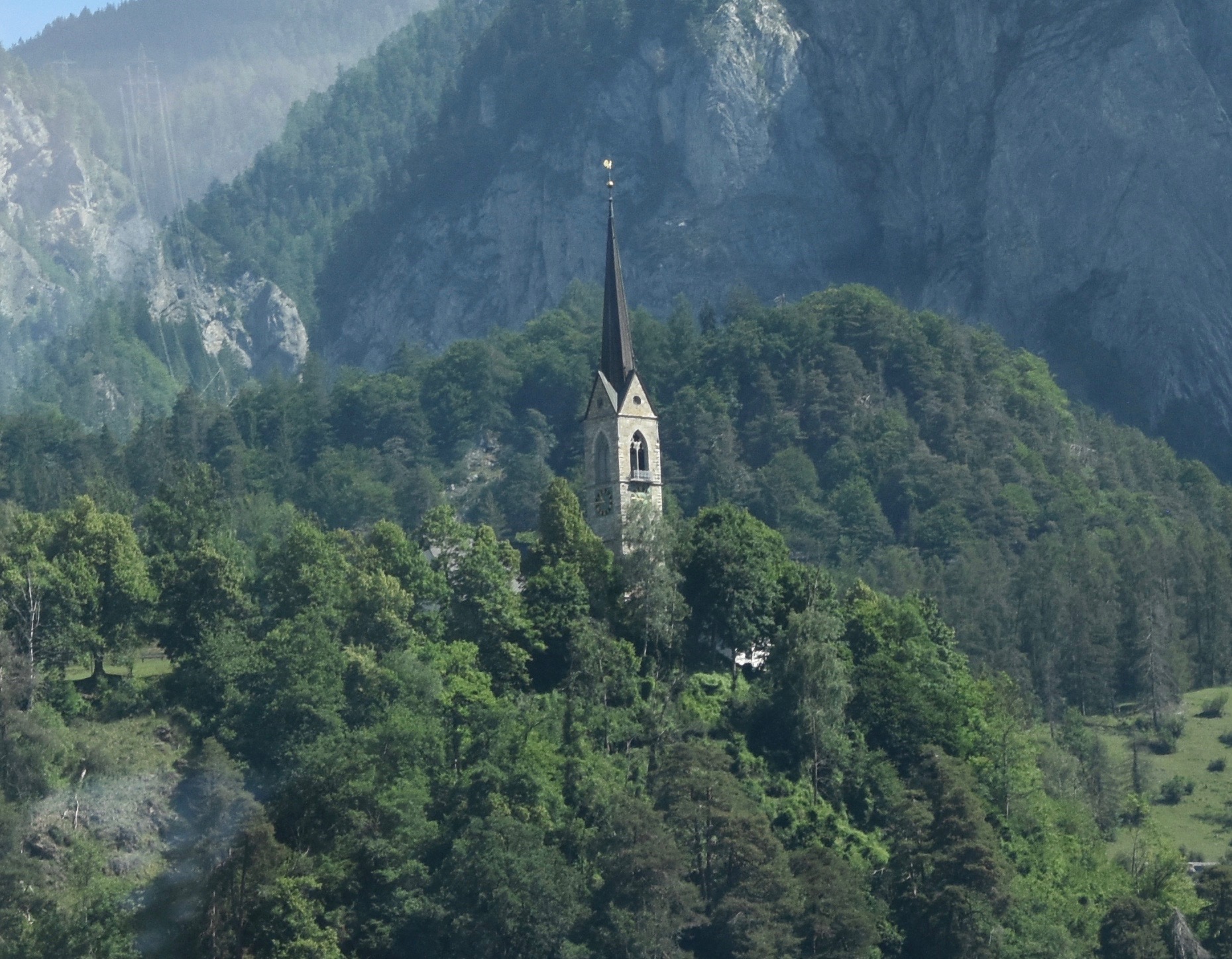
After a couple of hours we are finished our descent and enter the Rhine Valley where the river is chalky from the soft limestone through which it cuts a swath.
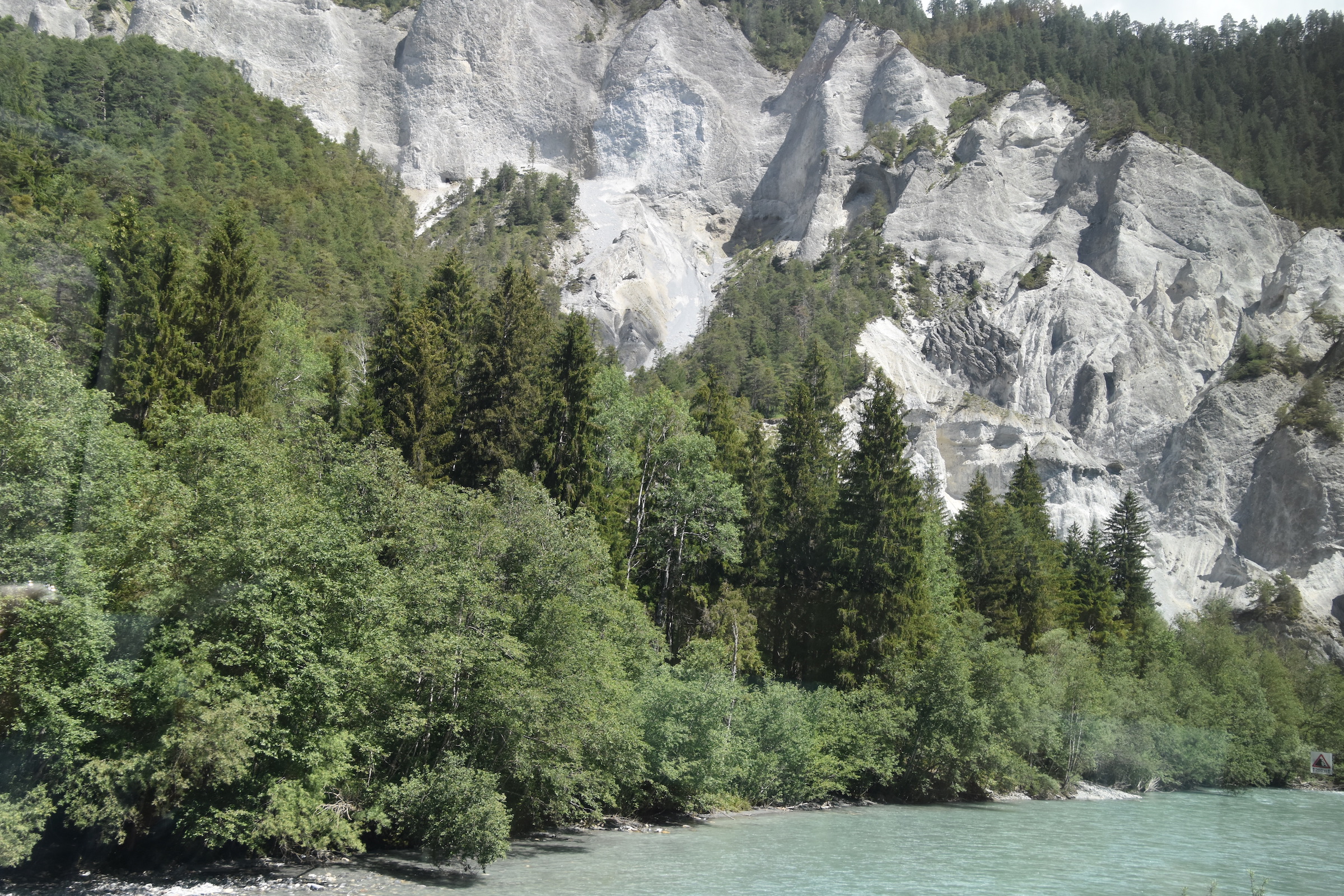
At Reichenau the Glacier Express comes to a junction and inexplicably goes right toward Chur and away from the intended destination of Zermatt. The train makes its first stop at Chur, reminding us that people other than just tourists actually use it to get from place to place. From Chur it reverses direction and heads toward Zermatt. Everybody who had a seat facing forward is now facing backwards and will be for the duration of the trip. So if you’ve rushed to get that forward facing seat at St. Moritz you are in for a cruel surprise at Chur.
Continuing along the very scenic Rhine Valley the Glacier Express crosses it in a number of places. It’s hard to believe that this is the same river that Alison and I saw a few days ago in Basel and which carries the commerce of five nations. Here it reminds me more of some of the great trout streams of Montana.
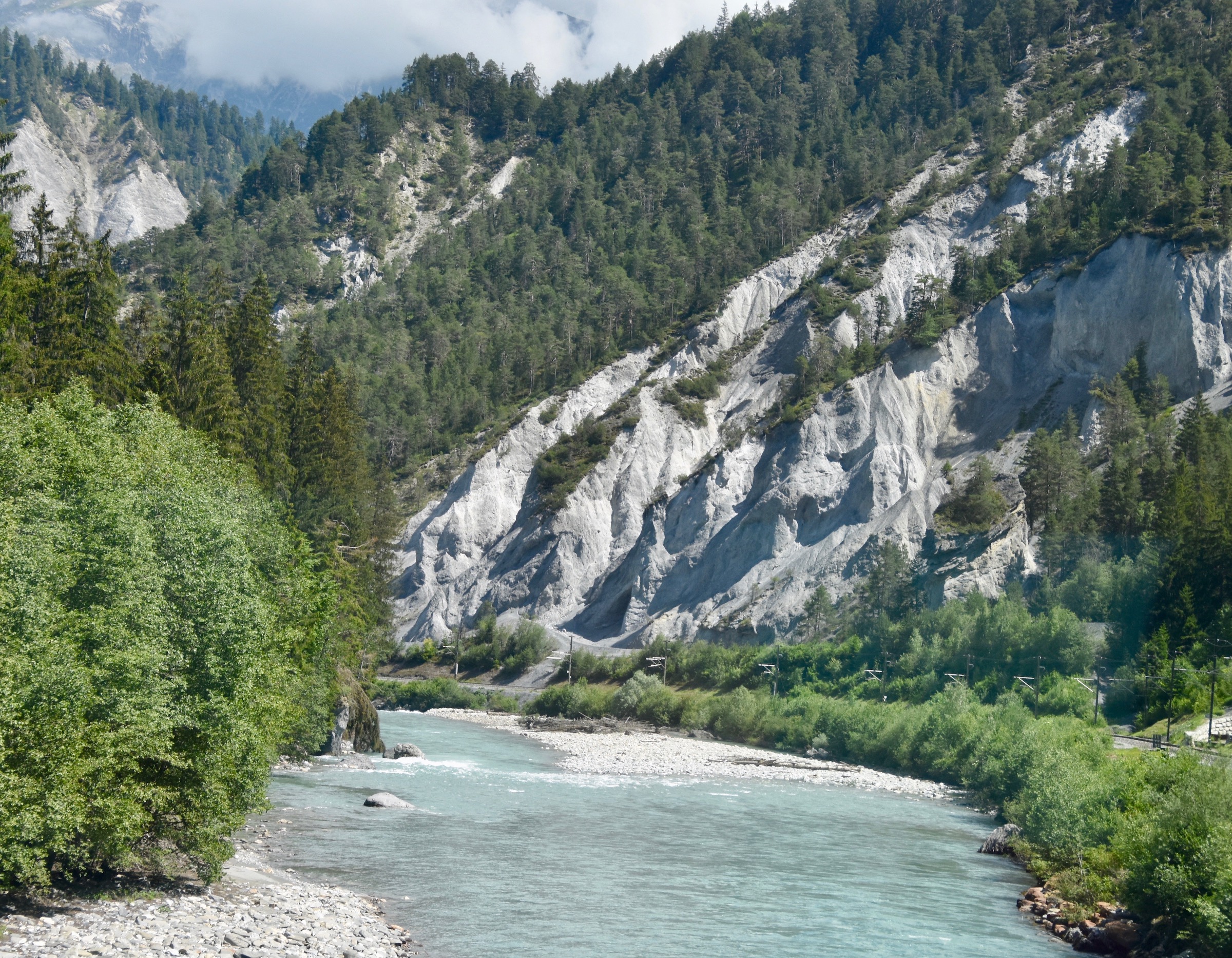
The sun is over the yard arm so we have a nice lunch accompanied by wine. As we are now beginning the long ascent to Oberalppass the wine in the glass indicates just that.
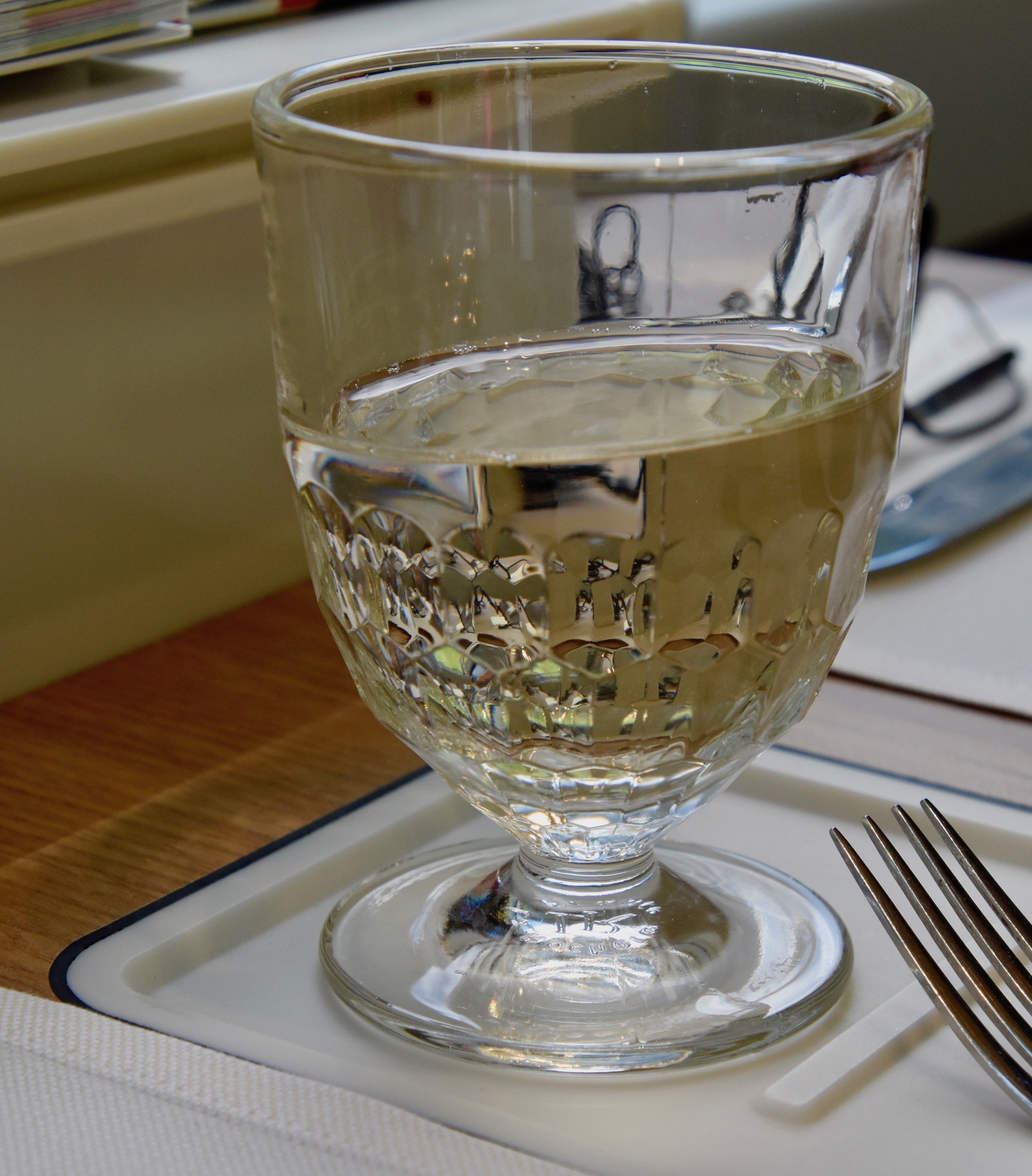
One of the features of Swiss rural life is the presence of these small dark structures that are actually hay barns. They are everywhere on the grassy slopes of the green meadows of the Rhine Valley.
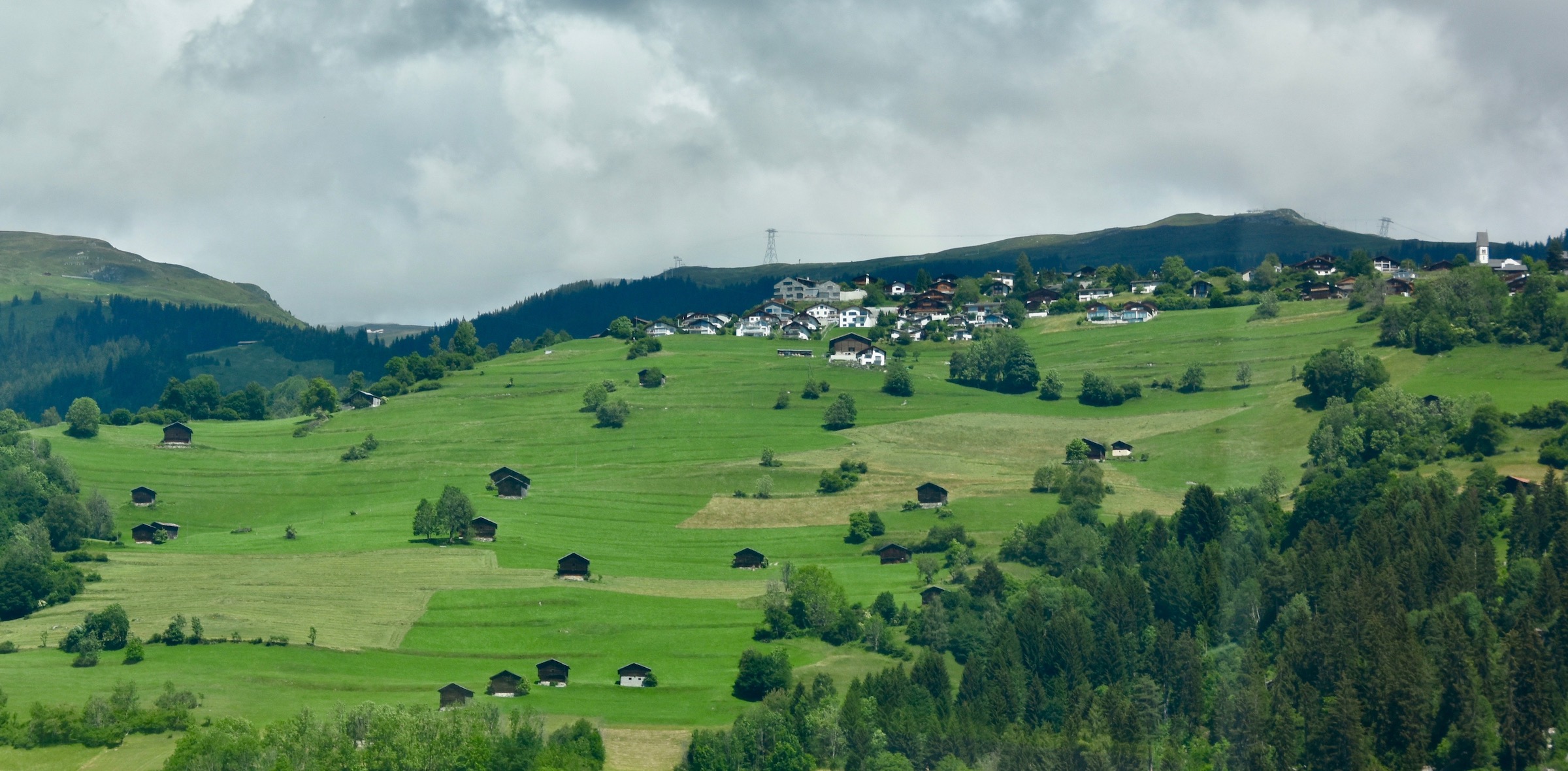
The train gradually climbs higher and higher and the meadows give way to forests and distant glaciers come into view reminding me why this is the Glacier Express.
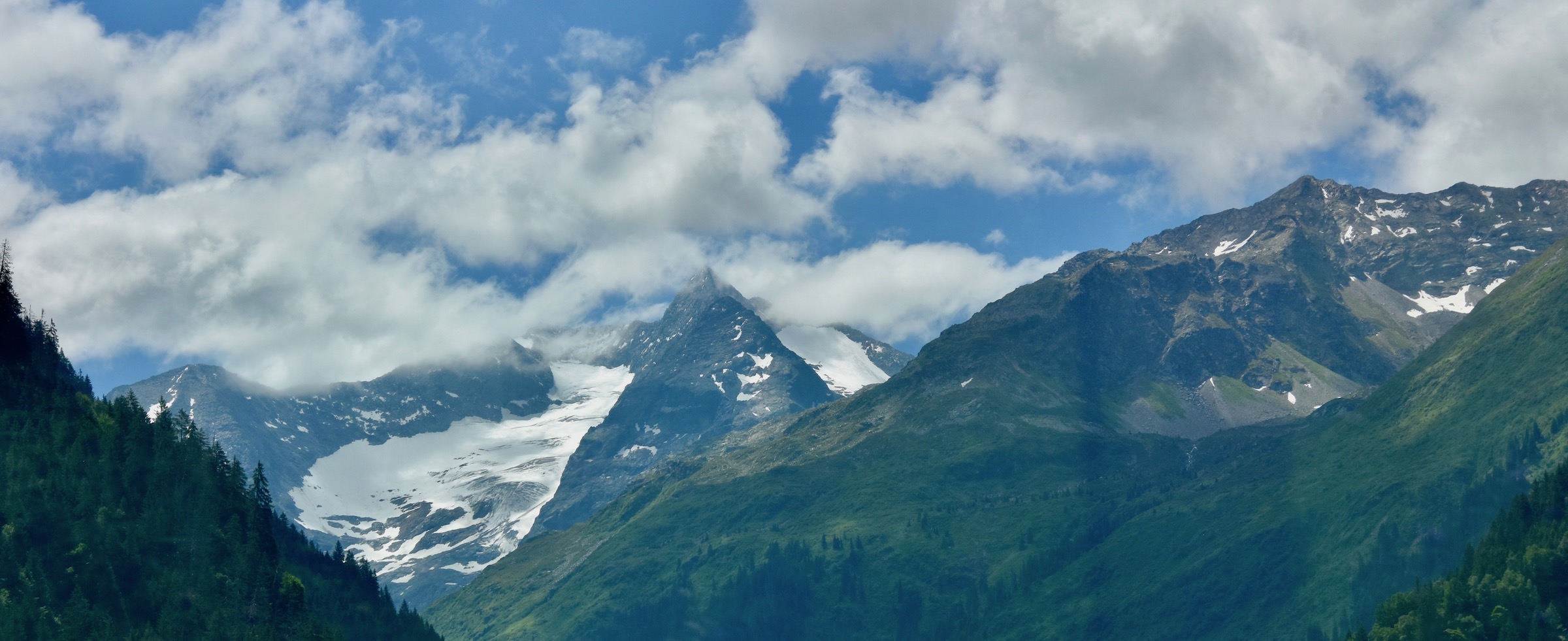
After about four hours we reach the halfway point of our journey at Oberalppass where we are allowed to disembark for a short photo break. At 2033 metres (6,670 feet) we are above the tree line and in an area where there is still snow on the ground well into June.
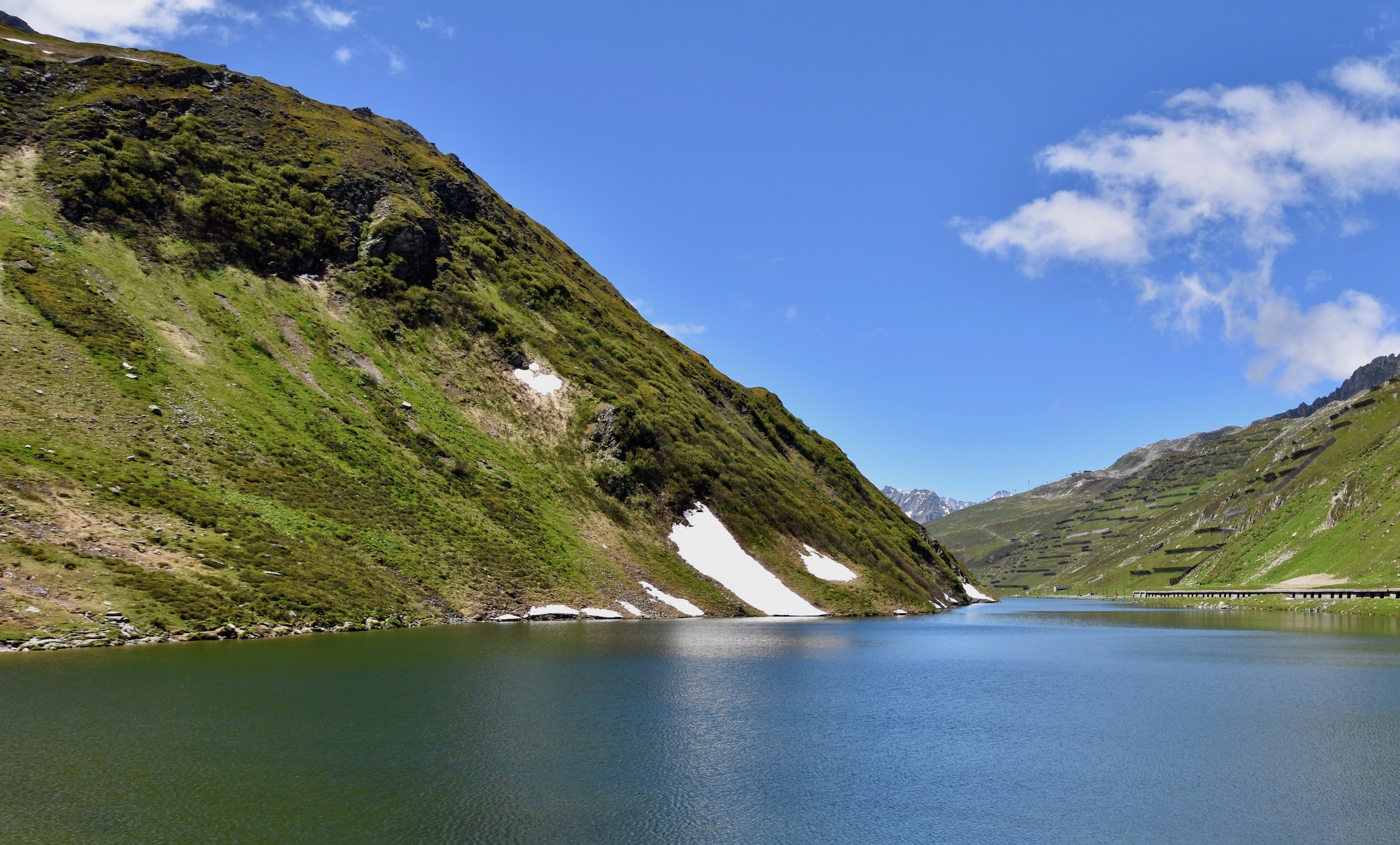
This is a view of the Glacier Express coming out of a snow shed on its way to St. Moritz.
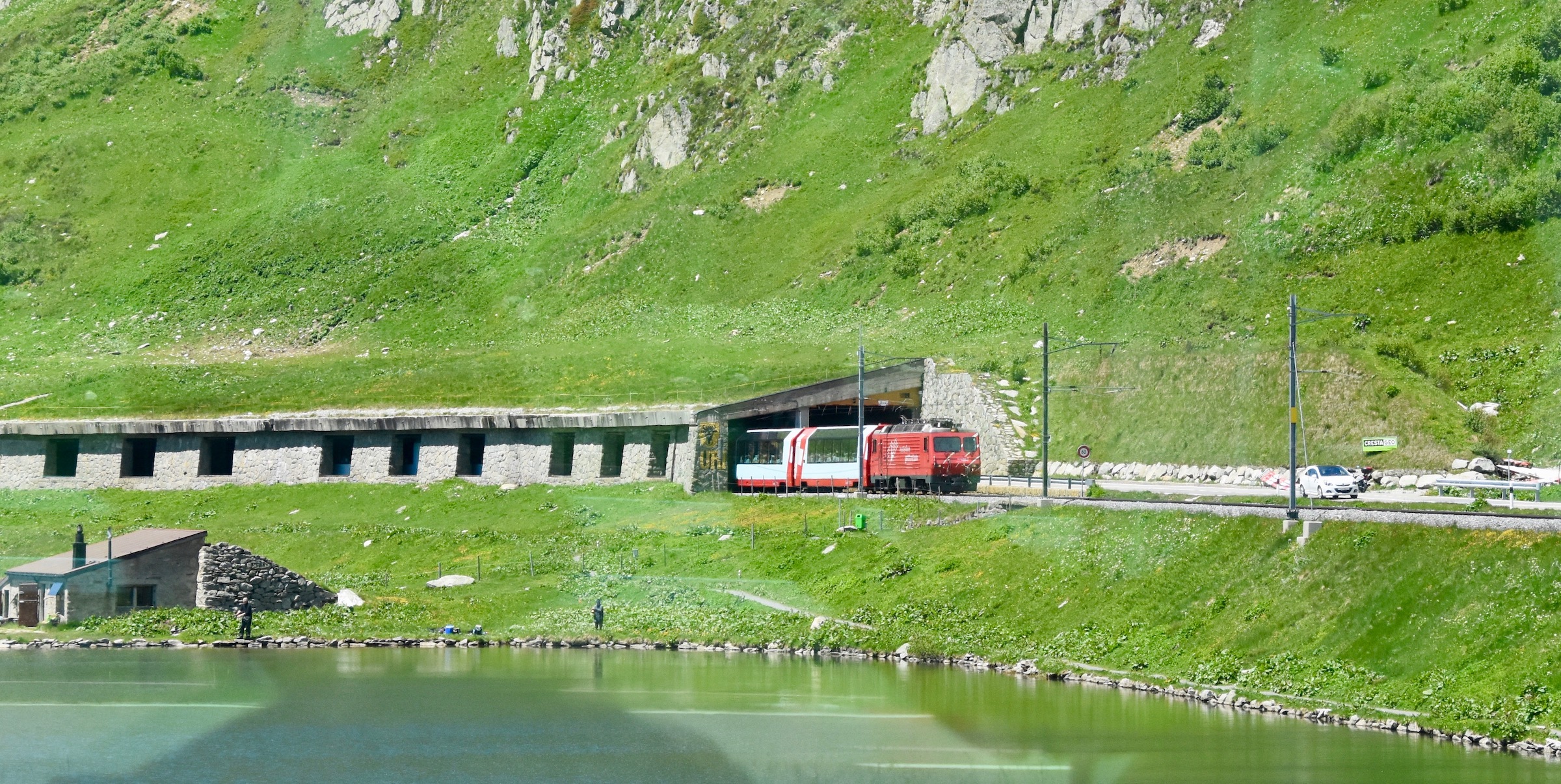
I believe this is Piz Blas, at 3019 metres (9,905 feet) it is the highest mountain in the Val Cadlimo area.
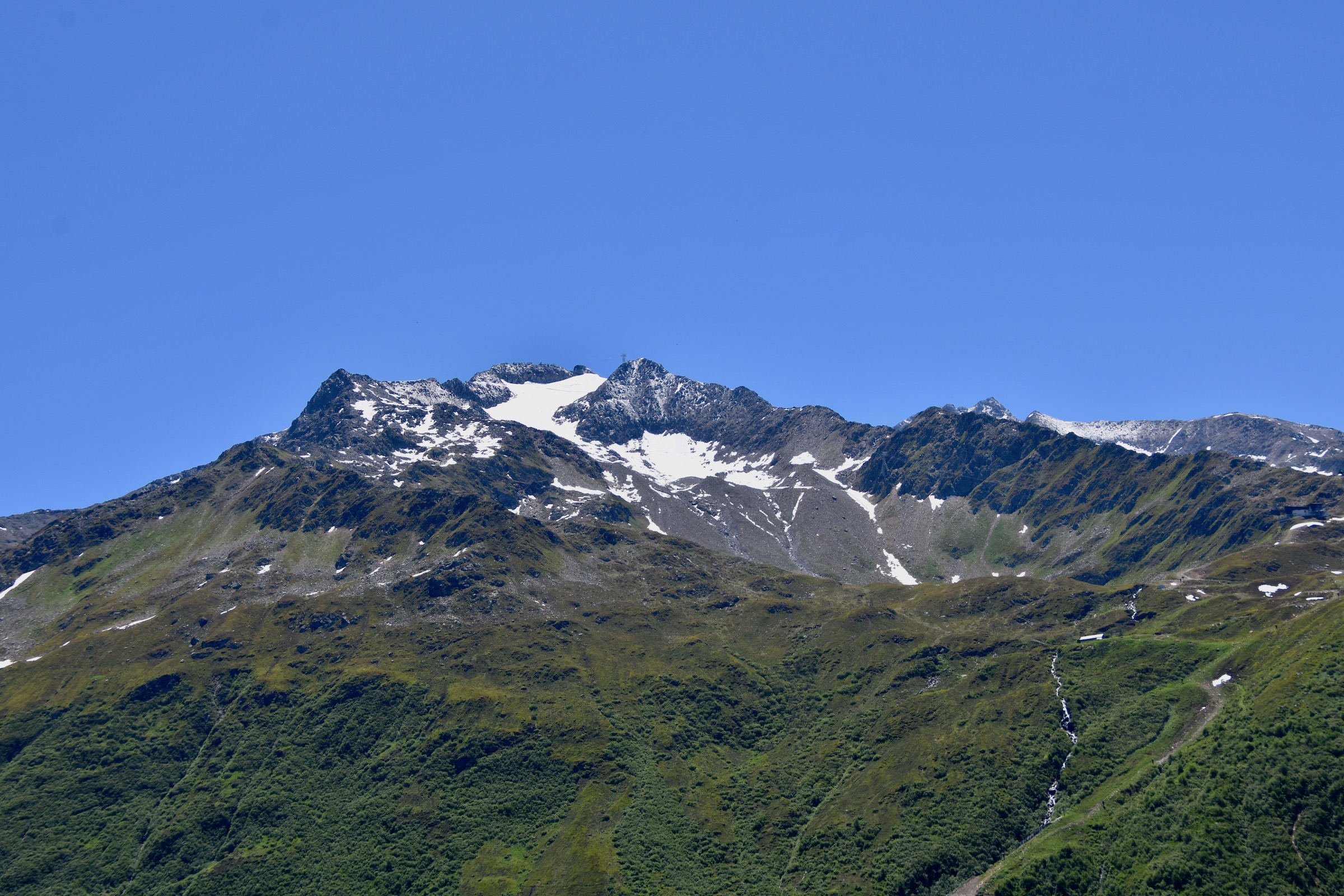
This is the view looking west in the direction we will head on descending from Oberalppass. It’s a long way down to the valley floor.
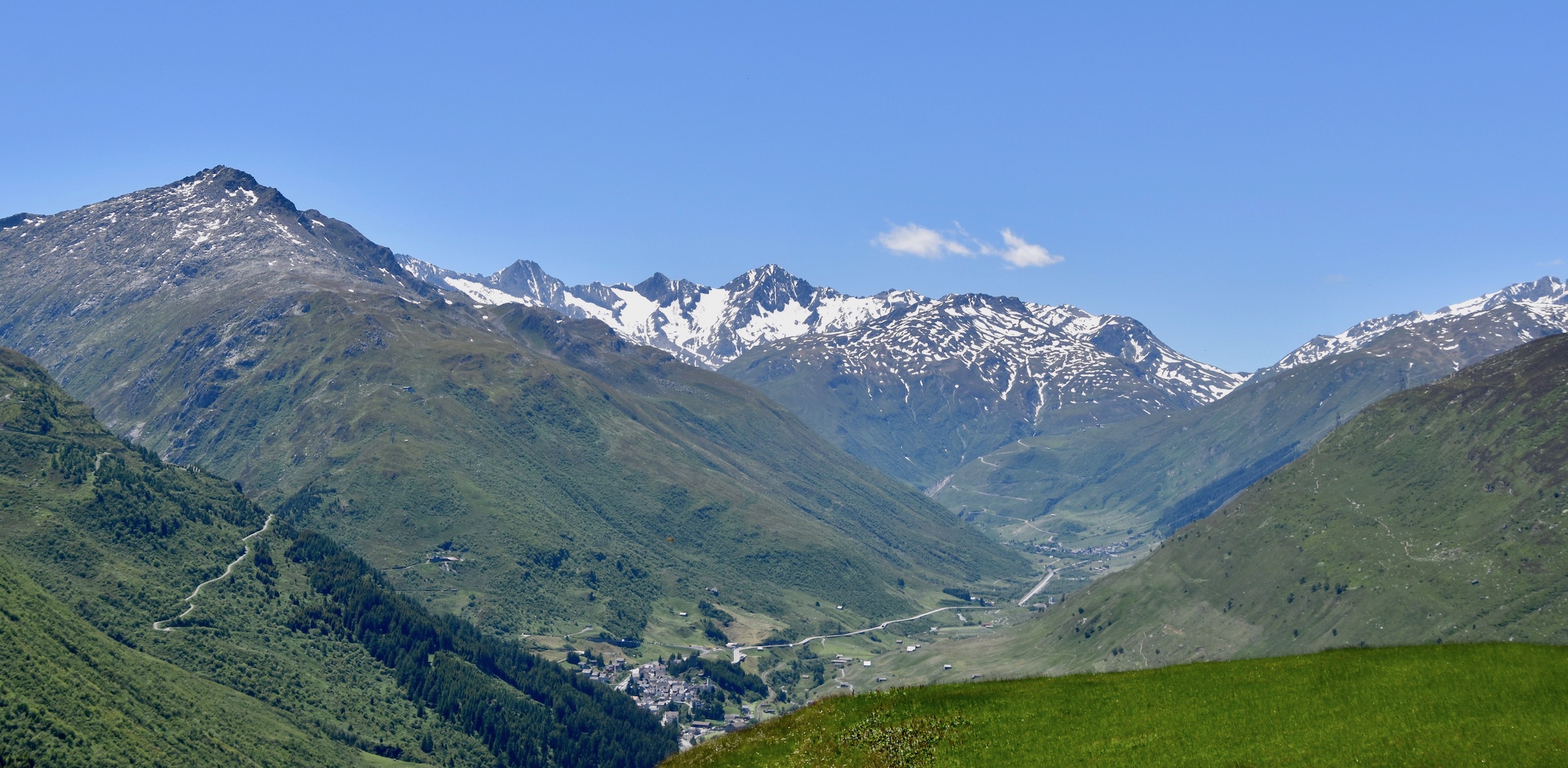
Finally, you might want to get someone to take your photo at this scenic viewpoint. I know most of the people in our group did.
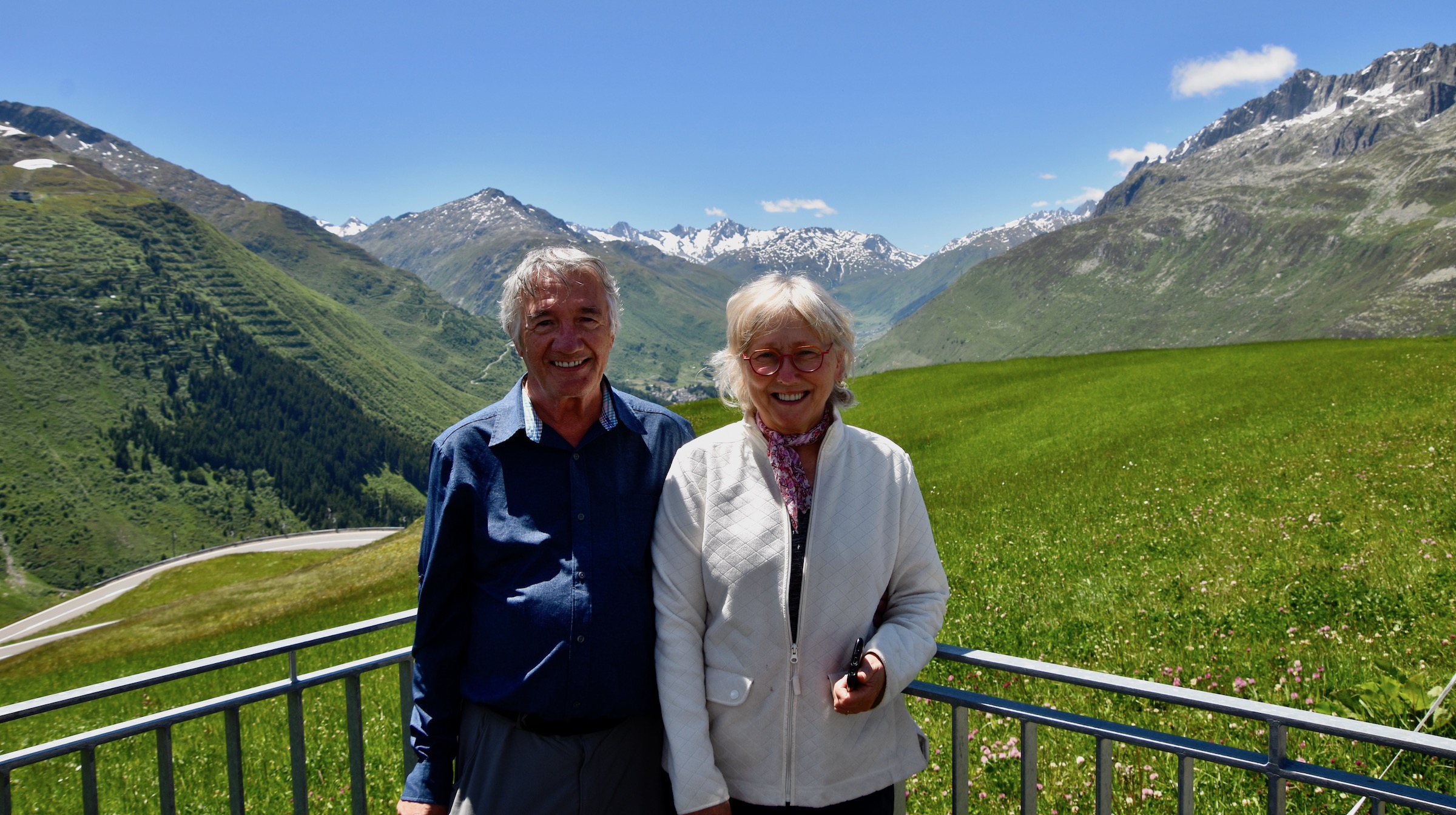
Now on the downslope we reentered forested areas and I caught a fleeting glimpse of this pedestrian suspension bridge over what chasm I do not know, but it looked like it would be a lot of fun to cross.
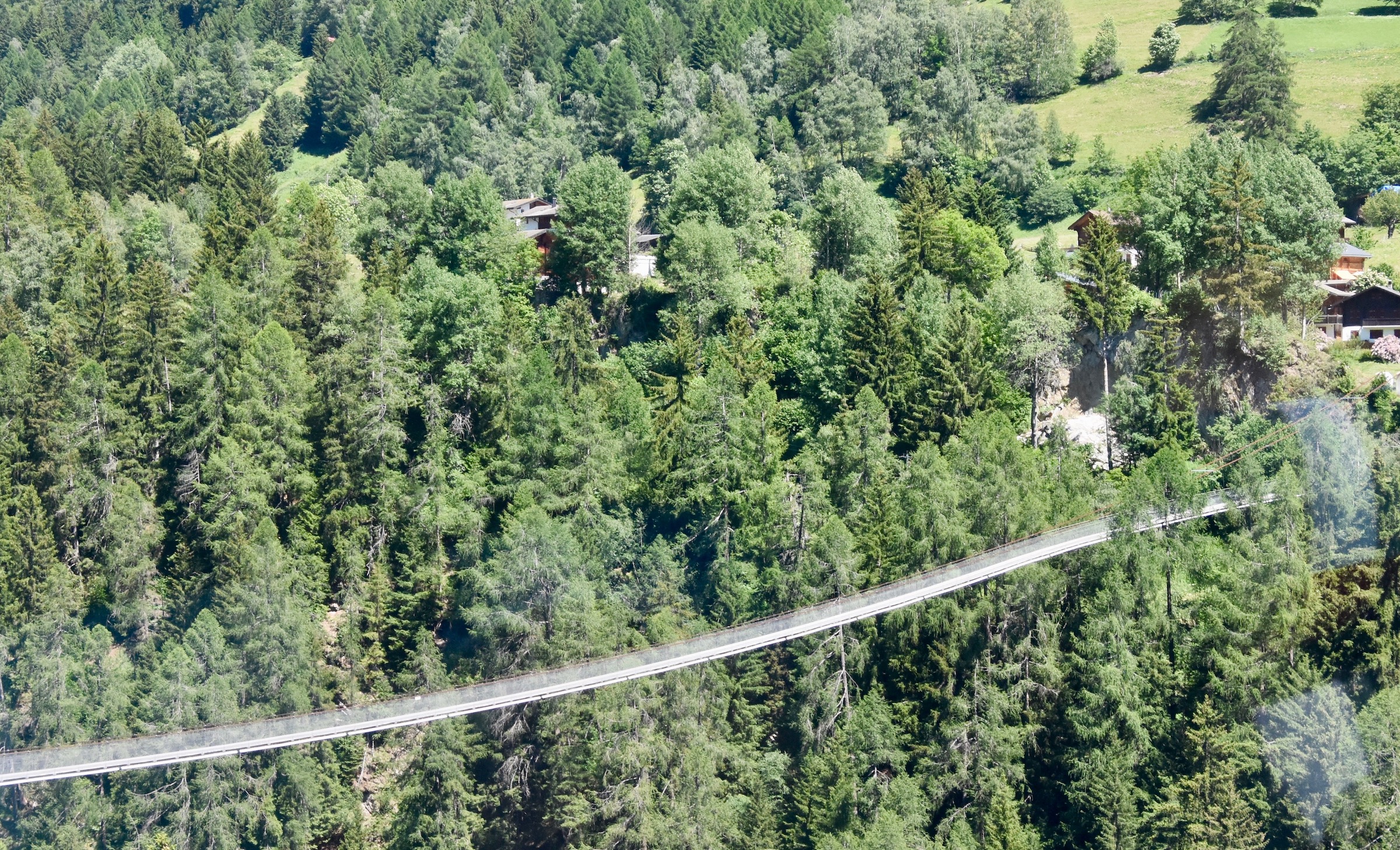
Back down in the valley the bucolic countryside rolled by.
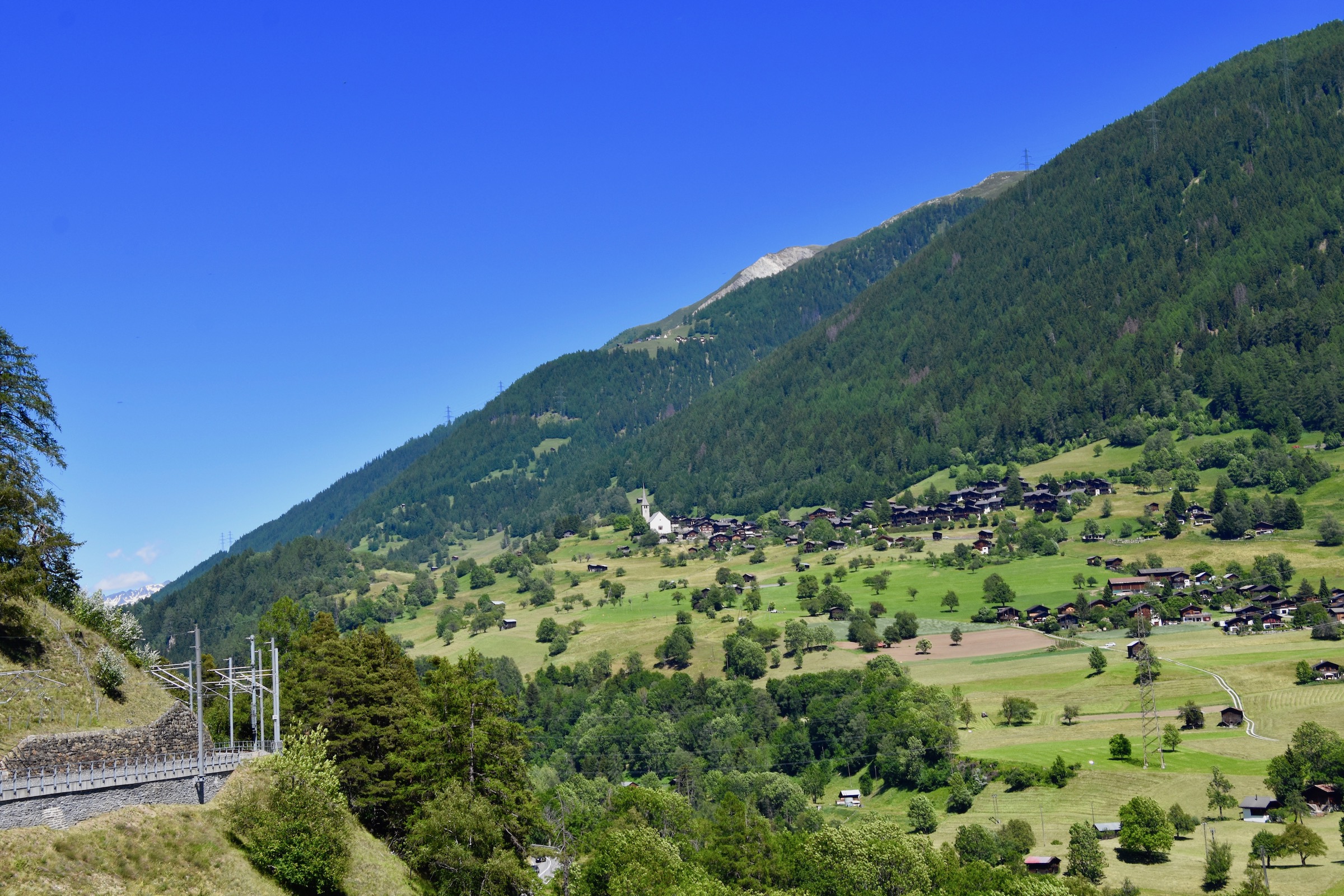
Then we starting climbing again to our final destination. I could not believe that the temperature in Zermatt as shown on the Glacier Express monitor was projected to be 27°C (80°F) when we arrived. No wonder the glaciers are melting. That’s just crazy for early June.
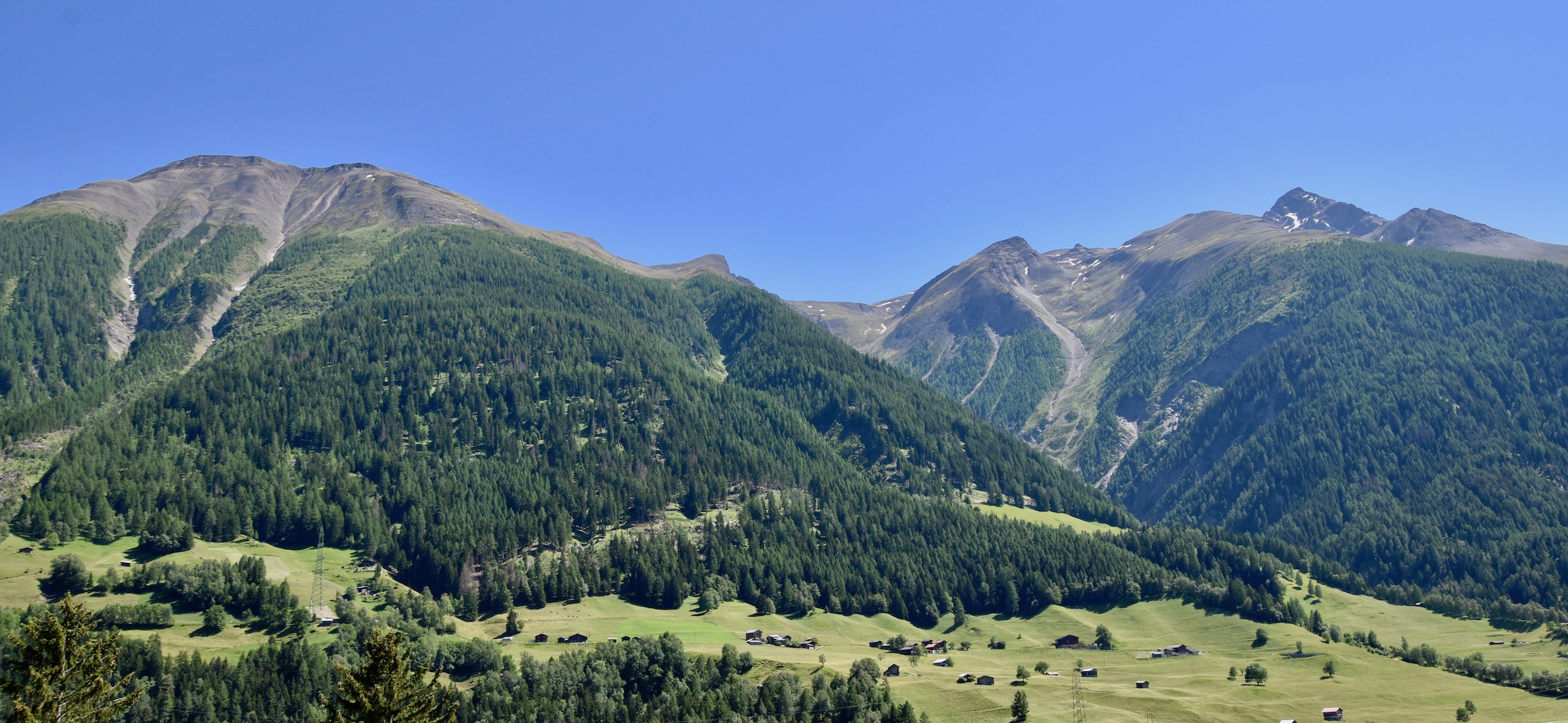
Apropos of warm temperatures, we started passing vineyards on the slopes.
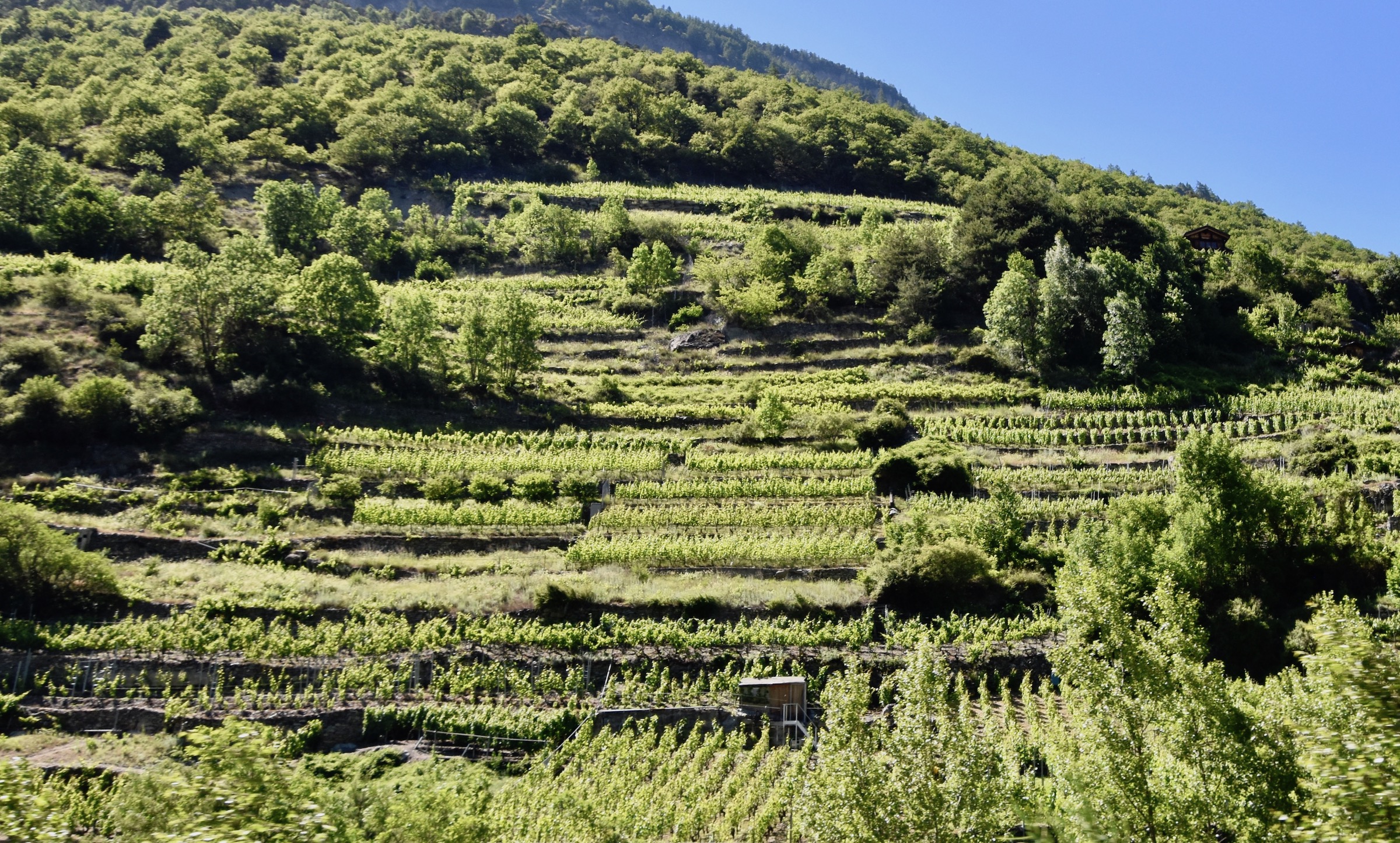
The final climb to Zermatt was the steepest on the entire route and the valley got progressively narrower with numerous waterfalls tumbling over steep cliffs.
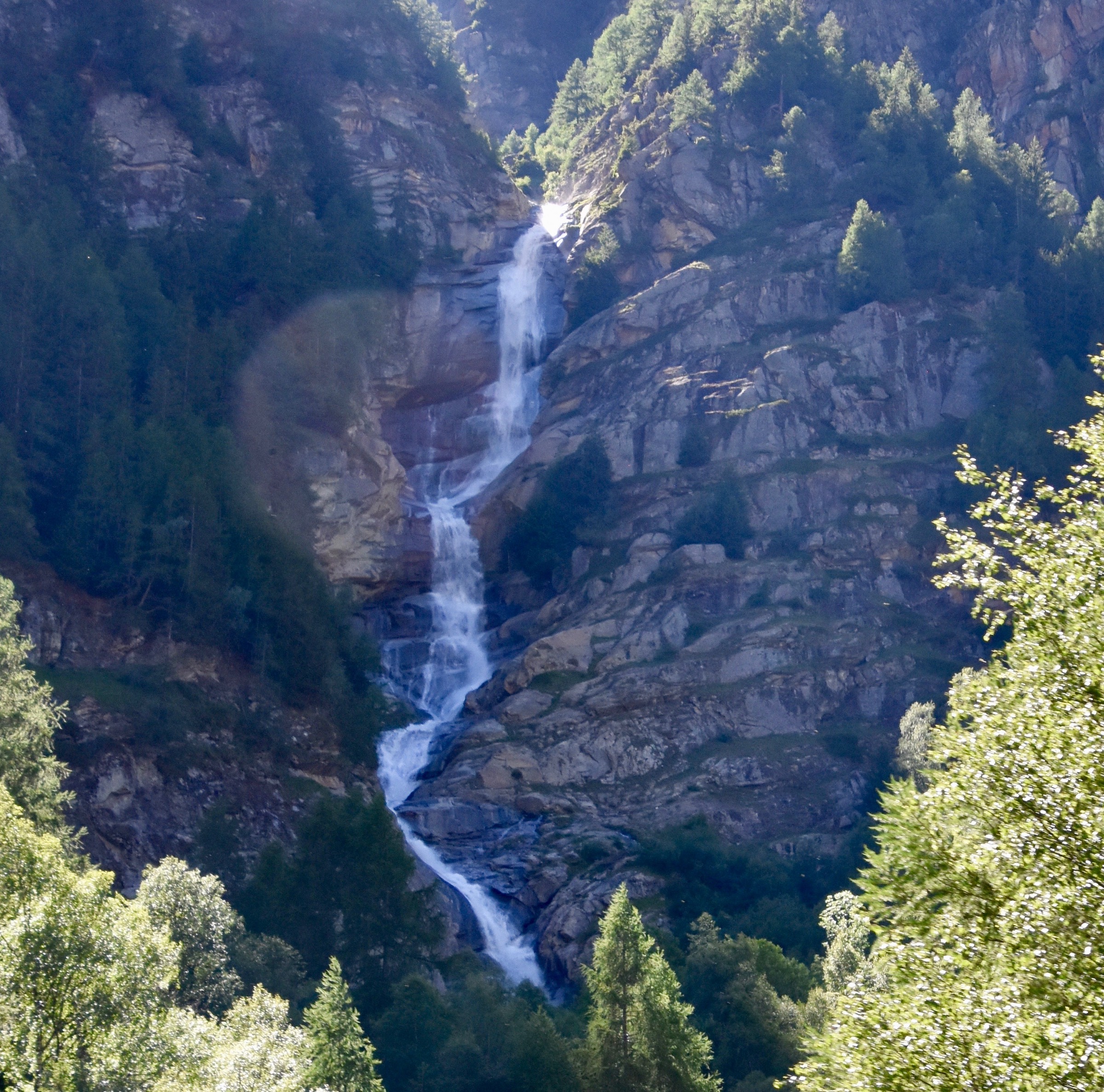
Once again glaciers came into view.
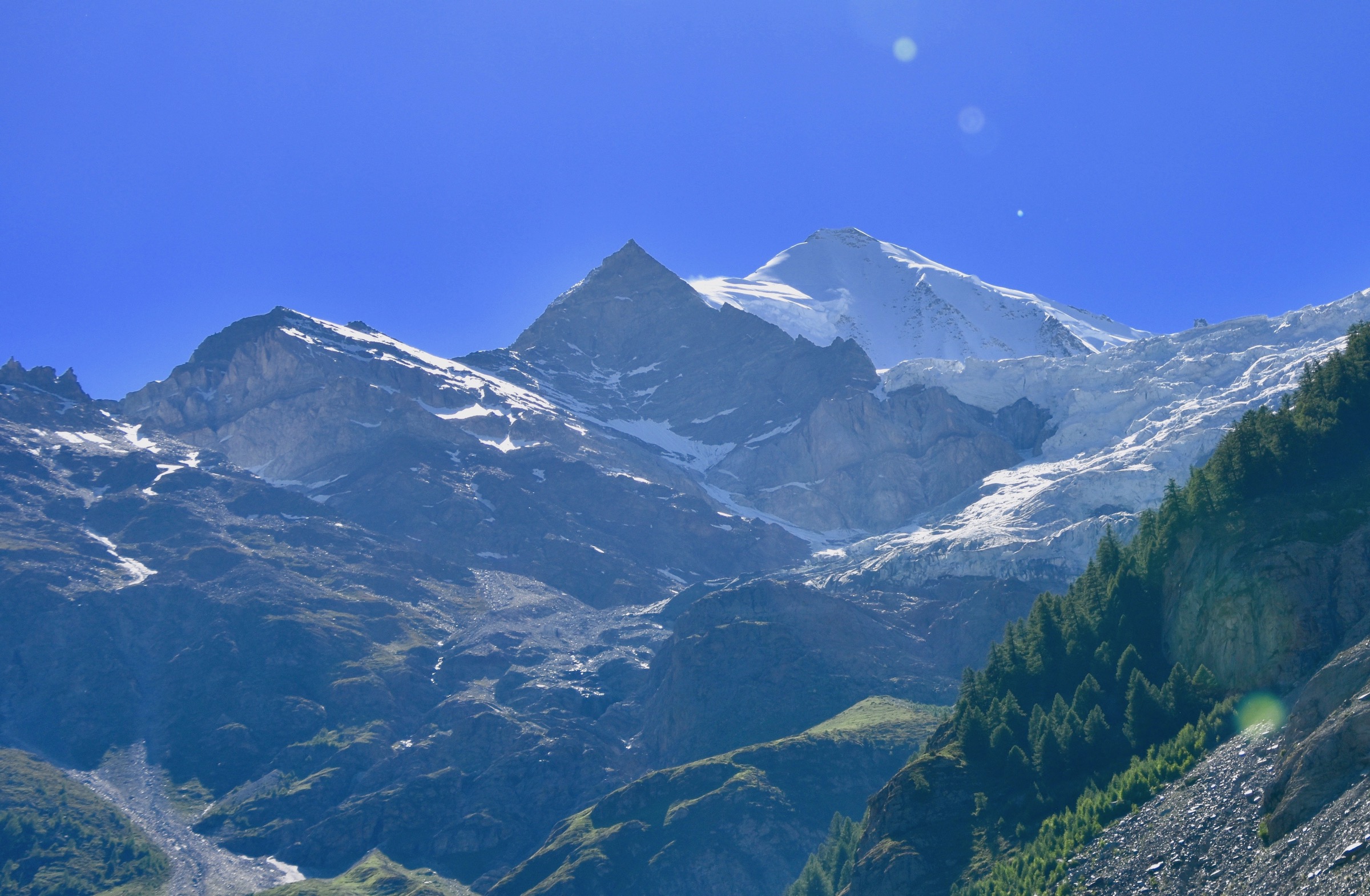
Everybody was thirsting for the first look at the Matterhorn which dominates the Zermatt landscape, but it was nowhere in sight. I have seen pictures of the Glacier Express with the Matterhorn in the background, but despite the best efforts of pretty well everyone on the train it could not be seen. So if you have the idea that your entry into Zermatt will include the Matterhorn, shelve it for now. But don’t worry we’ll get to see plenty of it over the next day or two. Not that the views were not terrific anyway (nice double negative).
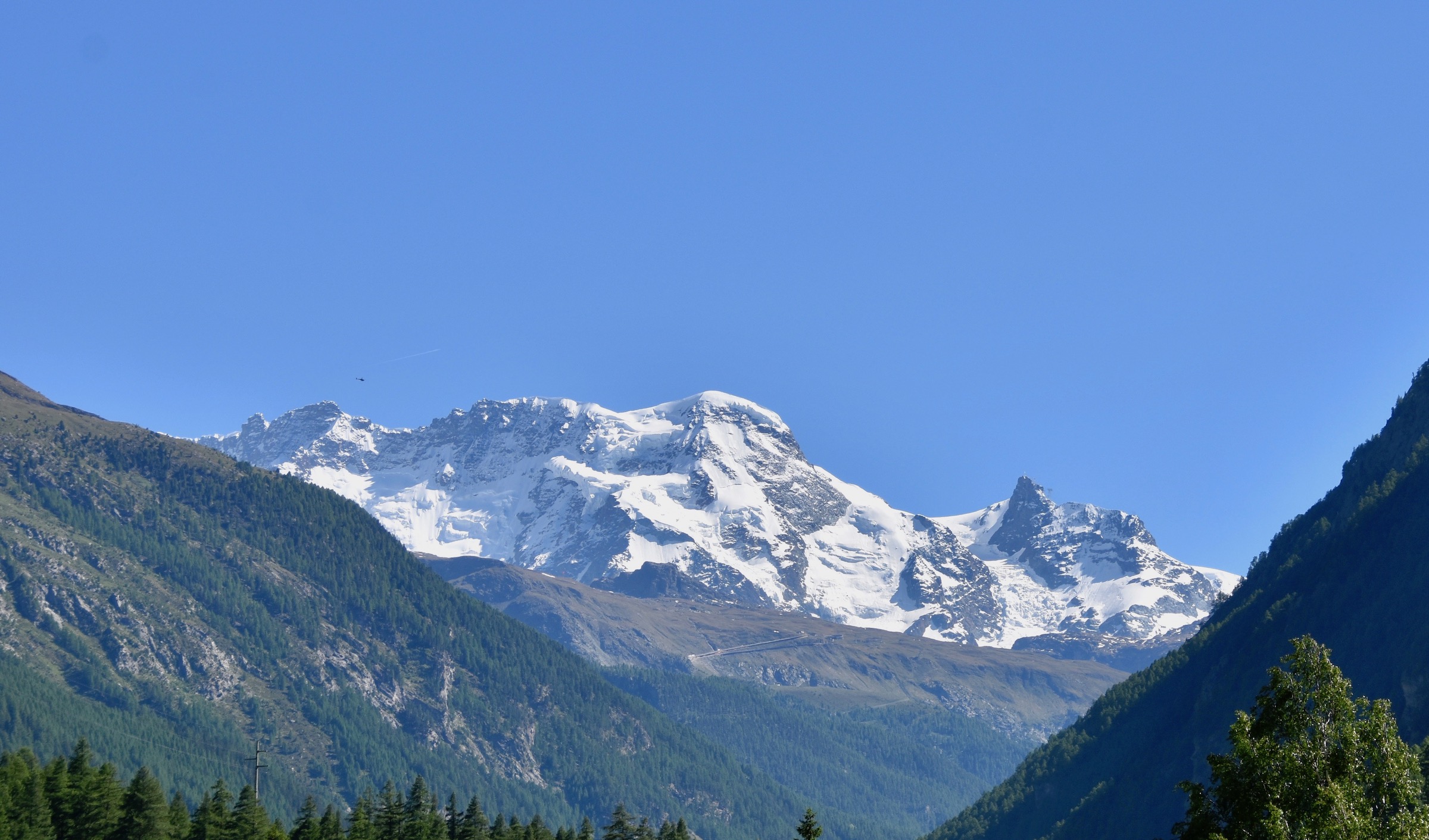
The first sign of human habitation in a while comes with these slate roofed houses and sheds.
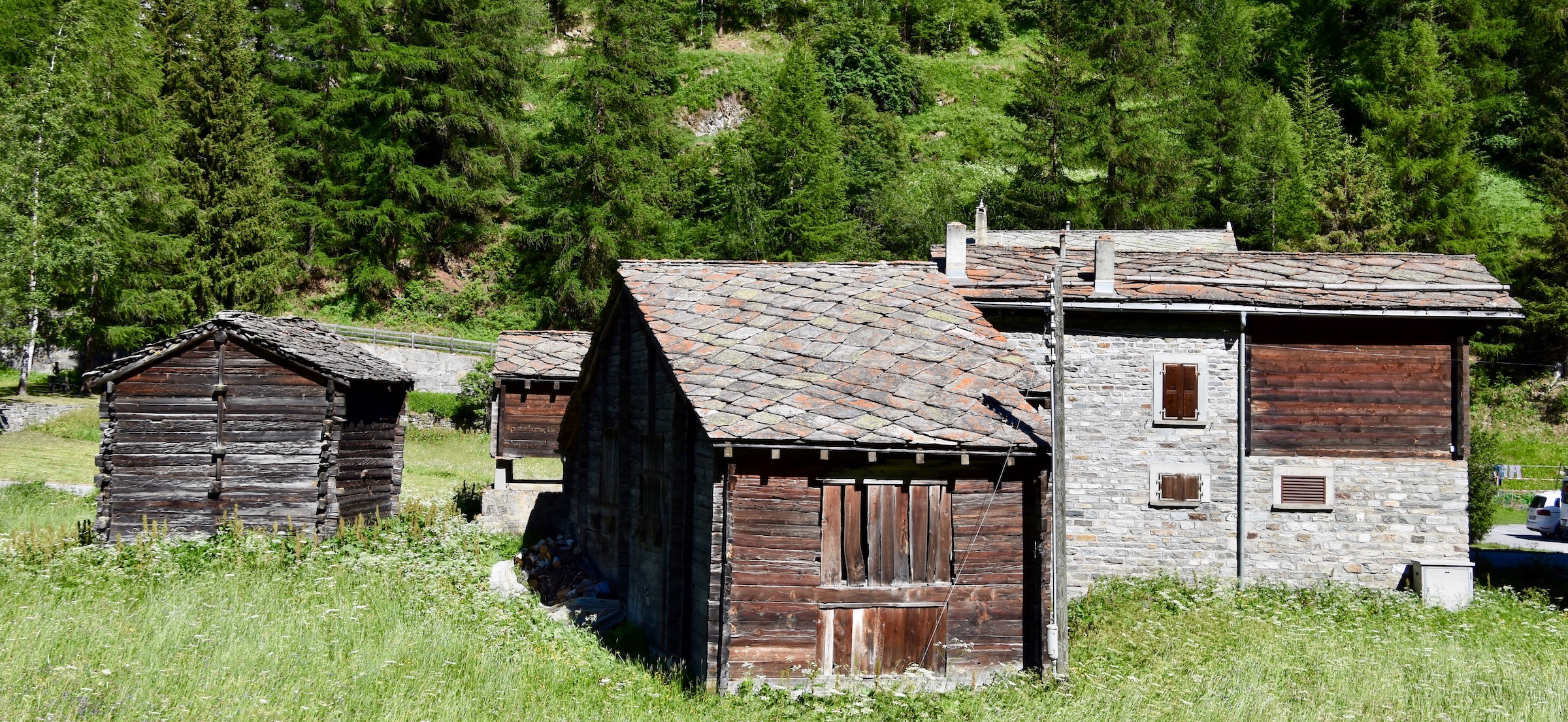
Then, almost as an anticlimax, we are stopping at Zermatt station. I step outside and my God, it really is 27 degrees. One of the great attractions about Zermatt is that it is car free, There are small electric carts that deliver luggage and supplies to the hotels and other businesses, but other than that it’s getting around by foot power only.
We say goodbye to the Glacier Express and Victor leads the way to our lodgings in Zermatt, the Hotel Butterfly.
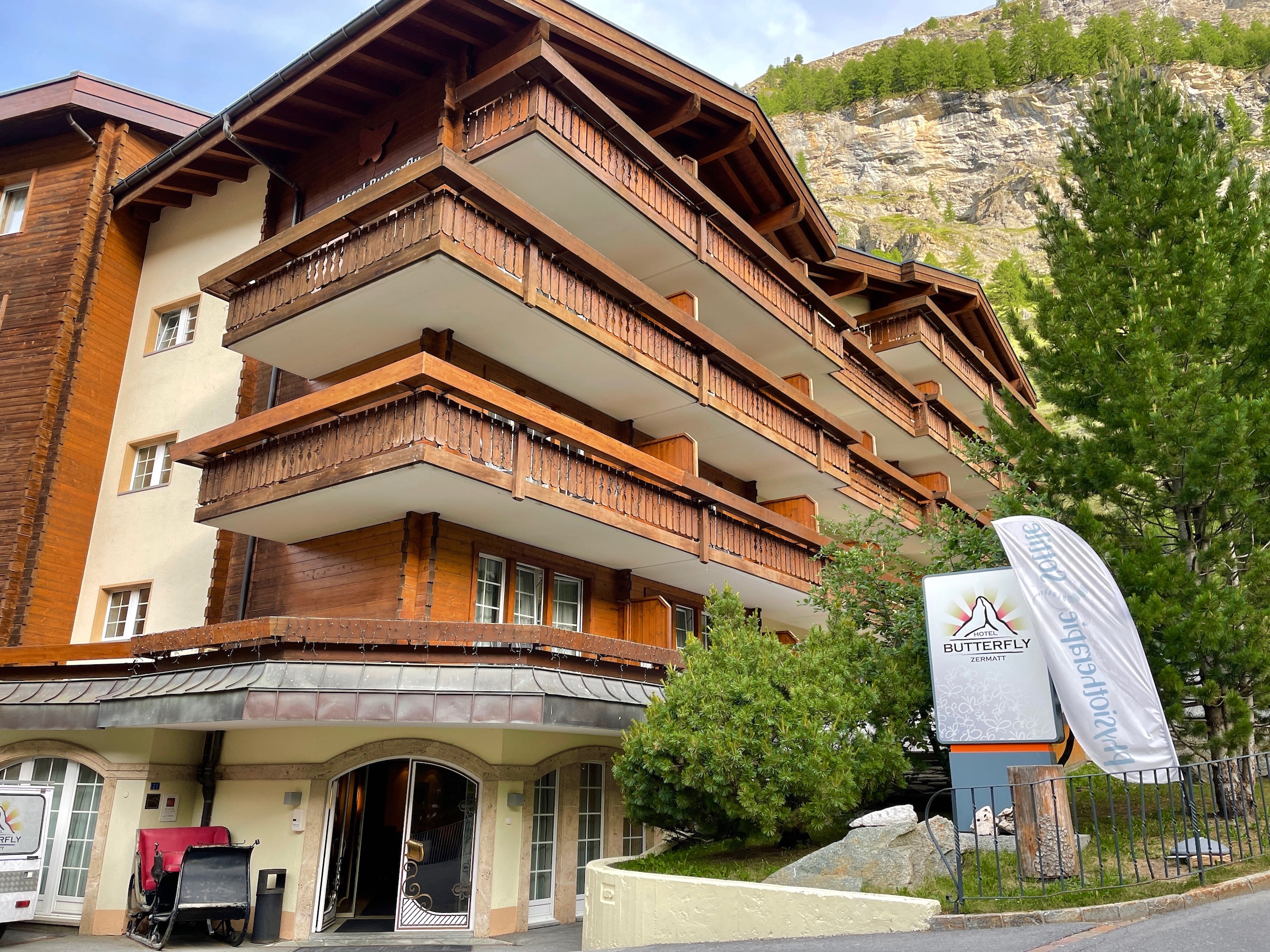
After a quick check in Alison and I head out in search of, you guessed it, the Matterhorn, which continues to elude us. We follow the main street higher and higher until rounding a corner and there it is, perhaps the most iconic mountain in the world.
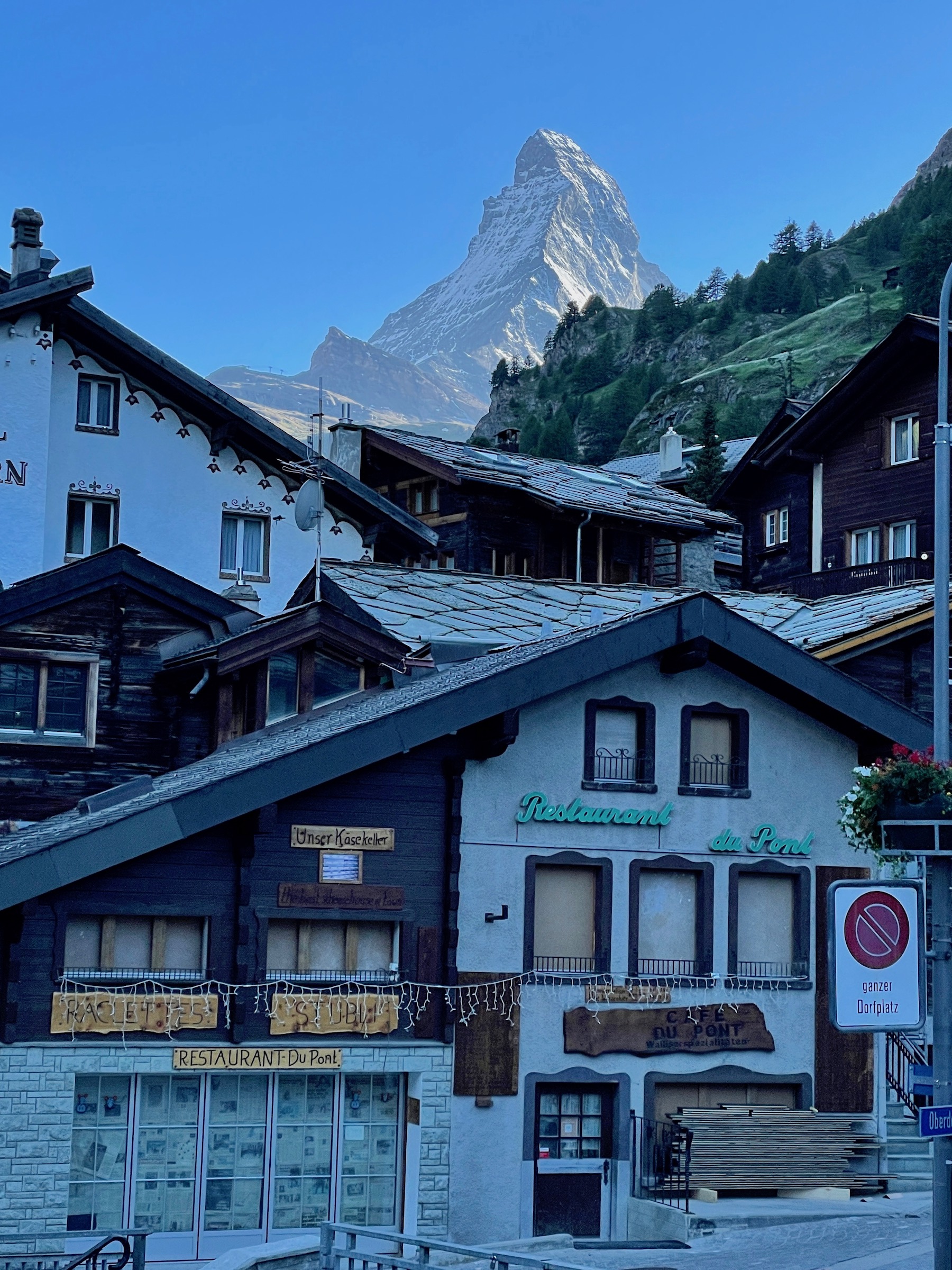
We keep on going for a better look and get rewarded with this view.
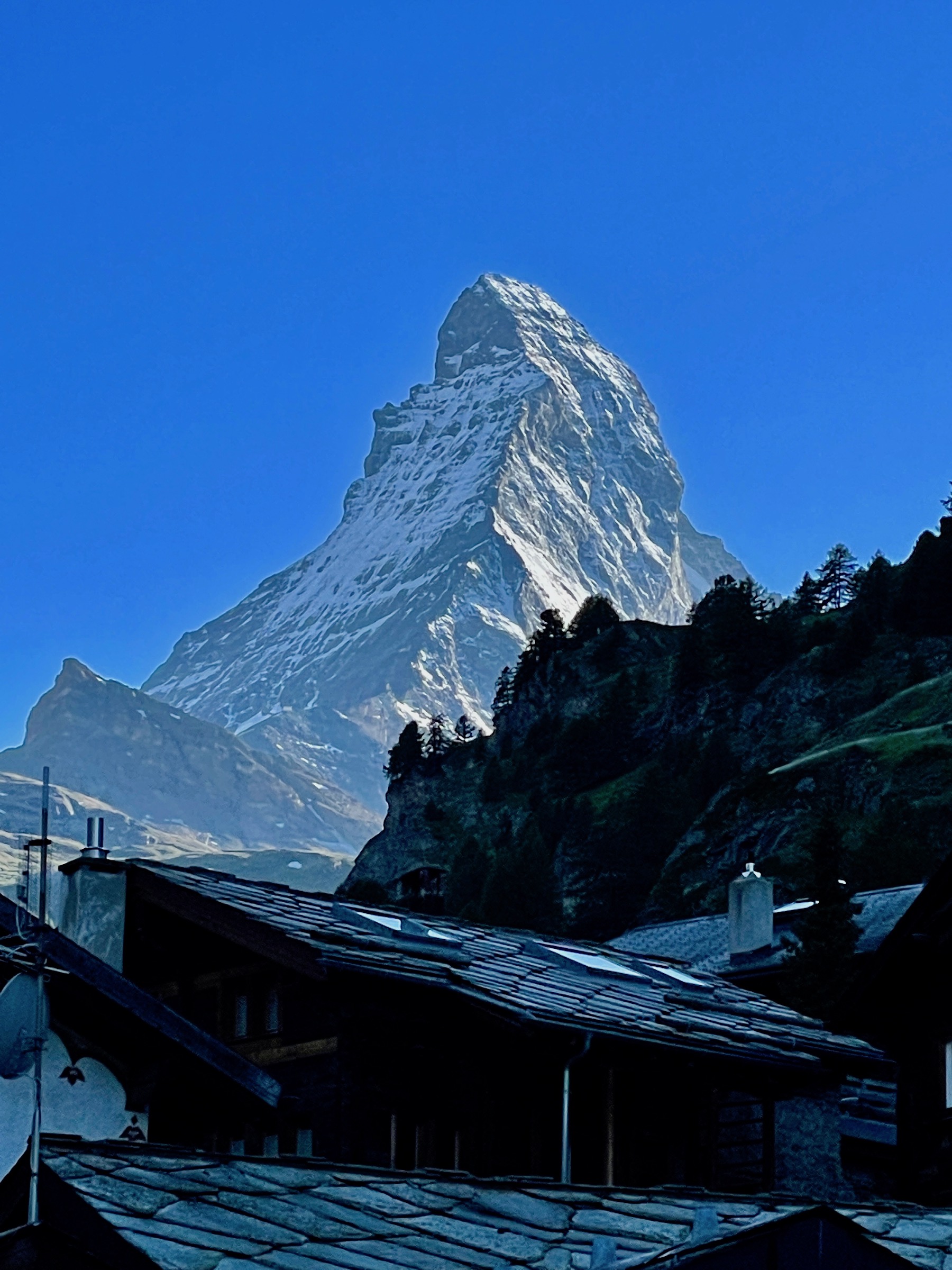
Tomorrow we will get a lot closer, but for now we’ve had our Matterhorn fix and can reflect back on the tremendous journey from St. Moritz to Zermatt on the Glacier Express.

